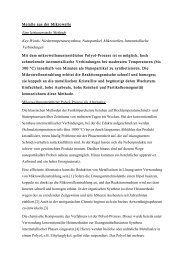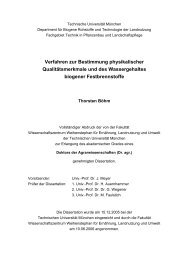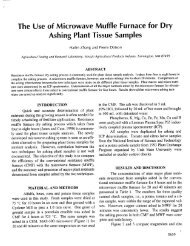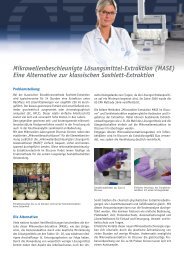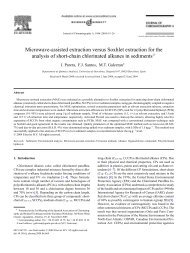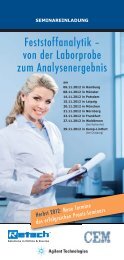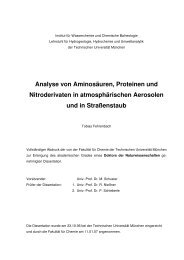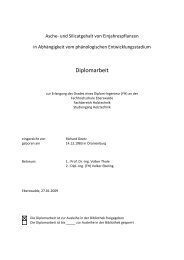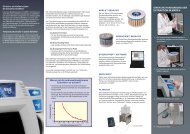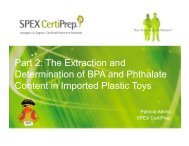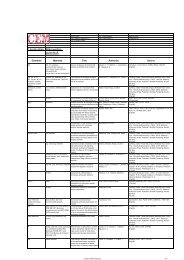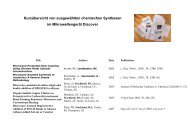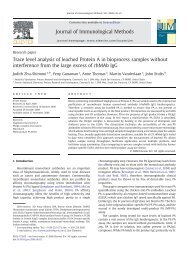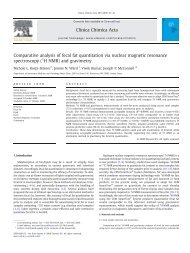Recent Advances in Microwave- Assisted Synthesis
Recent Advances in Microwave- Assisted Synthesis
Recent Advances in Microwave- Assisted Synthesis
You also want an ePaper? Increase the reach of your titles
YUMPU automatically turns print PDFs into web optimized ePapers that Google loves.
66<br />
VOL. 37, NO.2 • 2004<br />
<strong>Recent</strong> <strong>Advances</strong> <strong>in</strong> <strong>Microwave</strong>-<br />
<strong>Assisted</strong> <strong>Synthesis</strong><br />
Outl<strong>in</strong>e<br />
1. A Brief Review of <strong>Microwave</strong> Theory<br />
2. Enhanced <strong>Microwave</strong> <strong>Synthesis</strong> (EMS)<br />
3. New Synthetic Applications<br />
4. Use of <strong>Microwave</strong> Irradiation <strong>in</strong> Biochemical Applications<br />
5. Conclusions and Future Trends<br />
6. Acknowledgement<br />
7. References<br />
Brittany L. Hayes †<br />
CEM Corporation, Life Sciences Division<br />
3100 Smith Farm Road, P.O. Box 200<br />
Matthews, NC 28106-0200, USA<br />
Email: brittany.hayes@cem.com<br />
1. A Brief Review of <strong>Microwave</strong> Theory<br />
The use of microwave irradiation <strong>in</strong> organic synthesis has<br />
become <strong>in</strong>creas<strong>in</strong>gly popular with<strong>in</strong> the pharmaceutical and<br />
academic arenas, because it is a new enabl<strong>in</strong>g technology for drug<br />
discovery and development. 1 By tak<strong>in</strong>g advantage of this efficient<br />
source of energy, compound libraries for lead generation and<br />
optimization can be assembled <strong>in</strong> a fraction of the time required<br />
by classical thermal methods.<br />
Presently, thermally driven organic transformations take place<br />
by either of two ways: conventional heat<strong>in</strong>g or microwaveaccelerated<br />
heat<strong>in</strong>g. In the first way, reactants are slowly activated<br />
by a conventional external heat source. Heat is driven <strong>in</strong>to the<br />
substance, pass<strong>in</strong>g first through the walls of the vessel <strong>in</strong> order to<br />
reach the solvent and reactants. This is a slow and <strong>in</strong>efficient<br />
method for transferr<strong>in</strong>g energy <strong>in</strong>to the react<strong>in</strong>g system. In the<br />
second way, microwaves couple directly with the molecules of the<br />
entire reaction mixture, lead<strong>in</strong>g to a rapid rise <strong>in</strong> temperature.<br />
S<strong>in</strong>ce the process is not limited by the thermal conductivity of the<br />
vessel, the result is an <strong>in</strong>stantaneous localized superheat<strong>in</strong>g of any<br />
substance that will respond to either dipole rotation or ionic<br />
conduction—the two fundamental mechanisms for transferr<strong>in</strong>g<br />
energy from microwaves to the substance(s) be<strong>in</strong>g heated. 1a<br />
The rate of a reaction is determ<strong>in</strong>ed by the Arrhenius equation<br />
(k = Ae -Ea/RT ), where T is the absolute temperature that controls the<br />
k<strong>in</strong>etics of the reaction. In conventionally heated reactions, this<br />
temperature is a bulk temperature (TB). <strong>Microwave</strong>-assisted<br />
reactions are different. <strong>Microwave</strong> irradiation will directly activate<br />
most molecules that possess a dipole or are ionic. S<strong>in</strong>ce energy<br />
transfer occurs <strong>in</strong> less than a nanosecond (10 -9 s), the molecules are<br />
unable to completely relax (~ 10 -5 s) or reach equilibrium. This<br />
creates a state of nonequilibrium that results <strong>in</strong> a high<br />
<strong>in</strong>stantaneous temperature (Ti) of the molecules and is a function<br />
of microwave power <strong>in</strong>put. The <strong>in</strong>stantaneous temperature is not<br />
directly measurable, but it is much greater than the measured TB (Ti<br />
>> TB). Thus, the greater the <strong>in</strong>tensity of microwave power be<strong>in</strong>g<br />
adm<strong>in</strong>istered to a chemical reaction, the higher and more<br />
consistent Ti will be. A precedence exists where the concept of<br />
<strong>in</strong>stantaneous temperatures has been used to expla<strong>in</strong> reactions<br />
occurr<strong>in</strong>g at a lower bulk temperature than expected, while us<strong>in</strong>g<br />
microwave irradiation. 2 In addition, <strong>in</strong> ultrasonic chemistry,<br />
extremely high and immeasurable temperatures are created that<br />
enhance the rates of chemical reactions by up to 1 million times. 3<br />
The <strong>in</strong>stantaneous temperature (Ti), not TB, ultimately determ<strong>in</strong>es<br />
the k<strong>in</strong>etics of microwave reactions.<br />
Based on experimental data from numerous studies that have<br />
been performed over the past ten years, chemists have found that<br />
microwave-enhanced chemical reaction rates can be faster than<br />
those of conventional heat<strong>in</strong>g methods by as much as 1,000-fold. 1<br />
Assum<strong>in</strong>g a standard first-order rate law (rate = k[A]), the<br />
Arrhenius rate equation has been used to calculate the<br />
<strong>in</strong>stantaneous temperatures required to get three different reaction<br />
enhancements (10-, 100-, and 1,000-fold). The assumption was<br />
based on a desired reaction bulk temperature of 150 °C and an<br />
activation energy of 50 kcal/mol for the transformation. For a 10fold<br />
rate <strong>in</strong>crease, it was determ<strong>in</strong>ed that a temperature<br />
enhancement of only 17 °C would be needed, relative to a bulk<br />
temperature of 150 °C. <strong>Microwave</strong> energy can provide that<br />
temperature <strong>in</strong>crease <strong>in</strong>stantly. Likewise, for a 100-fold rate<br />
<strong>in</strong>crease, the <strong>in</strong>stantaneous temperature would have to reach<br />
185 °C—approximately a 35 °C <strong>in</strong>crease over the bulk<br />
temperature. A 1000-fold enhancement would need a 56 °C<br />
<strong>in</strong>crease over TB. These <strong>in</strong>stantaneous temperatures are very<br />
consistent with the temperatures that would be expected <strong>in</strong> a<br />
microwave system and are directly responsible for the<br />
enhancements <strong>in</strong> reaction rates and yields. lm
2. Enhanced <strong>Microwave</strong> <strong>Synthesis</strong> (EMS)<br />
<strong>Recent</strong>ly, an alternative method for perform<strong>in</strong>g microwaveassisted<br />
organic reactions, termed “Enhanced <strong>Microwave</strong><br />
<strong>Synthesis</strong>” (EMS), has been exam<strong>in</strong>ed. 4 By externally cool<strong>in</strong>g the<br />
reaction vessel with compressed air, while simultaneously<br />
adm<strong>in</strong>ister<strong>in</strong>g microwave irradiation, more energy can be directly<br />
applied to the reaction mixture. In “Conventional <strong>Microwave</strong><br />
<strong>Synthesis</strong>” (CMS), the <strong>in</strong>itial microwave power is high, <strong>in</strong>creas<strong>in</strong>g<br />
the bulk temperature (TB) to the desired set po<strong>in</strong>t very quickly.<br />
However, upon reach<strong>in</strong>g this temperature, the microwave power<br />
decreases or shuts off completely <strong>in</strong> order to ma<strong>in</strong>ta<strong>in</strong> the desired<br />
bulk temperature without exceed<strong>in</strong>g it. When microwave<br />
irradiation is off, classical thermal chemistry takes over, los<strong>in</strong>g the<br />
full advantage of microwave-accelerated synthesis. With CMS,<br />
microwave irradiation is predom<strong>in</strong>antly used to reach TB faster.<br />
<strong>Microwave</strong> enhancement of chemical reactions will only take<br />
place dur<strong>in</strong>g application of microwave energy. 5 This source of<br />
energy will directly activate the molecules <strong>in</strong> a chemical reaction;<br />
therefore, it is not desirable to suppress its application. EMS<br />
ensures that a high, constant level of microwave energy is applied.<br />
Research published very recently <strong>in</strong> lead<strong>in</strong>g organic synthesis<br />
journals supports the use of simultaneous cool<strong>in</strong>g of reactions<br />
be<strong>in</strong>g heated by microwave energy. 6–8 Simultaneous cool<strong>in</strong>g<br />
enables a greater amount of microwave energy to be <strong>in</strong>troduced<br />
<strong>in</strong>to a reaction, while keep<strong>in</strong>g the reaction temperature low. This<br />
results <strong>in</strong> significantly greater yields and cleaner chemistries.<br />
EMS was employed <strong>in</strong> the synthesis of a variety of α-keto amides<br />
to support a protease <strong>in</strong>hibitor discovery project. This may<br />
eventually lead to improved treatments for stroke, Alzheimer’s<br />
disease, and muscular dystrophy. 6 Follow<strong>in</strong>g an earlier protocol<br />
from the 1960s, the authors coupled acyl chlorides with various<br />
isonitriles. α-Keto imidoyl chloride <strong>in</strong>termediates were formed,<br />
which were then converted to the α-keto amides upon hydrolysis<br />
(Scheme 1). Under conventional heat<strong>in</strong>g conditions, this took<br />
between 2 to 6 hours for completion; whereas under optimized<br />
EMS conditions, the two steps were completed <strong>in</strong> 2 m<strong>in</strong> and <strong>in</strong><br />
21–74% yields.<br />
EMS has also been beneficial <strong>in</strong> produc<strong>in</strong>g higher release<br />
levels of the desired amides from the solid-phase res<strong>in</strong>, as<br />
compared with microwave heat<strong>in</strong>g alone (Scheme 2). 7<br />
More recently, Katritzky et al. illustrated the advantages of<br />
EMS <strong>in</strong> prepar<strong>in</strong>g bistriazoles by the 1,3-dipolar cycloaddition<br />
reactions of 1,4-bis(azidomethyl)benzene with monoacetylenes. 8<br />
When react<strong>in</strong>g the diazide with a carbamoylpropiolate at 120 W<br />
and 55 °C for 30 m<strong>in</strong>utes, cycloaddition only occurred at one of<br />
the azido moieties. Higher temperatures and irradiation powers<br />
resulted <strong>in</strong> decomposition. By us<strong>in</strong>g EMS for the reaction<br />
between the diazide and butynoate at 120 W and 75 °C for 1 hour,<br />
the Katritzky group successfully synthesized the bistriazole<br />
(eq 1). The major isomer was isolated <strong>in</strong> 54–65% yields.<br />
3. New Synthetic Applications<br />
The recent publication of several major reviews on<br />
microwave-assisted organic synthesis notwithstand<strong>in</strong>g, 1a,b,l a<br />
plethora of very recent articles describ<strong>in</strong>g a variety of new<br />
chemistries performed with microwave irradiation have appeared.<br />
This section will document many of these synthetic applications.<br />
Table 1, at the end of this section, provides an <strong>in</strong>-depth summary<br />
of the wide range of microwave-assisted applications that are not<br />
discussed here <strong>in</strong> detail. 2,4,5e,6–246<br />
In organometallic chemistry, two of the most phenomenal<br />
recent discoveries are transition-metal-free Suzuki and Sonogashira<br />
coupl<strong>in</strong>gs. 9 Leadbeater and coworkers have shown that react<strong>in</strong>g an<br />
R2 R<br />
CN<br />
1 O<br />
neat, µw<br />
Cl<br />
+<br />
100 W, 1 m<strong>in</strong><br />
simultaneous<br />
cool<strong>in</strong>g<br />
R1 = Ph, phenethyl, 4-anisyl, 1-naphthyl<br />
R2 = n-Bu, Bn, Cy<br />
R1 O H<br />
N<br />
R<br />
O<br />
2<br />
21–74%<br />
CaCO 3, H2O<br />
µw, 100 W, 1 m<strong>in</strong><br />
Ref. 6<br />
simultaneous<br />
cool<strong>in</strong>g<br />
R1 O<br />
N<br />
R<br />
Cl<br />
2<br />
Scheme 1. Improved <strong>Synthesis</strong> of α-Keto Amides by Enhanced<br />
<strong>Microwave</strong> <strong>Synthesis</strong> (EMS).<br />
N 3<br />
HO O<br />
N 3<br />
N<br />
O<br />
N R<br />
O<br />
1<br />
R2 R3 28–100%<br />
CO 2Et<br />
O NHR<br />
PS<br />
R 1 COCl, AcOH<br />
DCM, µw<br />
300 W, 110 o C<br />
2 x 10 m<strong>in</strong><br />
O OH<br />
N<br />
O<br />
toluene, µw<br />
120 W, 75<br />
simultaneous<br />
cool<strong>in</strong>g<br />
oC, 1 h<br />
1,3-Dipolar Cycloaddition<br />
Ref. 8<br />
R Major Isomer<br />
C6H5 54%<br />
4-MeC6H4 65%<br />
activated aryl bromide with an arylboronic acid <strong>in</strong> water, us<strong>in</strong>g<br />
tetrabutylammonium bromide (TBAB) as a phase-transfer<br />
catalyst, results <strong>in</strong> a successfully coupled biaryl Suzuki product<br />
without the aid of a palladium catalyst (eq 2). 9b In addition, a<br />
transition-metal-free Sonogashira reaction between an aryl<br />
bromide or iodide and phenylacetylene results <strong>in</strong> respectable<br />
yields (eq 3). 9c In this case, poly(ethylene glycol) is used as the<br />
phase-transfer agent.<br />
Buchwald–Hartwig chemistry has become a powerful method<br />
for synthesiz<strong>in</strong>g arylam<strong>in</strong>es. Conventionally, this reaction requires<br />
high temperatures and long reaction times. Many fast and highly<br />
efficient applications have been developed <strong>in</strong> conjunction with<br />
N<br />
N<br />
N<br />
O NHR<br />
RHN<br />
CO2Et<br />
O<br />
CO 2Et<br />
N<br />
N N<br />
eq 1<br />
Br B(OH) 2<br />
TBAB<br />
Na2CO3, H2O<br />
µw, 100 W<br />
150<br />
1 R o R R<br />
C, 5 m<strong>in</strong><br />
1<br />
R<br />
50–99%<br />
R = H, 2-Me, 4-Me, 2-OMe, 3-OMe, 4-OMe, 4-Ac, 4-CHO, 4-NO2, 4-NH2, 4-CO2H, 4-CO2Me, 2,6-Me2, 2-Pyr<br />
R<br />
Pd-Catalyst-Free Suzuki Coupl<strong>in</strong>g<br />
Ref. 9b<br />
1 = H, 4-Me, 4-Ac<br />
eq 2<br />
PS<br />
O O<br />
R 1<br />
O<br />
N<br />
PS<br />
O<br />
(i) R 2 R 3 NH, MeOH, µw, 200 W, 125 o C, 0.5 h, cont<strong>in</strong>uous cool<strong>in</strong>g.<br />
(ii) Dowex ® 50WX res<strong>in</strong>, rt, 1 h.<br />
Ref. 7<br />
(i), (ii)<br />
R 1 = Pr, i-Pr, Ph, 4-MeOC6H4, 3,5-Cl2C6H3; R 2 = n-Bu, Bn, Ph<br />
R 3 = H; R 2 ,R 3 = CH(CH 3)(CH 2) 4<br />
Scheme 2. Improved Release Levels of Amides<br />
from Res<strong>in</strong> by EMS.<br />
Brittany L. Hayes<br />
VOL. 37, NO.2 • 2004<br />
67
68<br />
<strong>Recent</strong> <strong>Advances</strong> <strong>in</strong> <strong>Microwave</strong>-<strong>Assisted</strong> <strong>Synthesis</strong><br />
VOL. 37, NO.2 • 2004<br />
R<br />
R 1<br />
Br<br />
NHR<br />
N<br />
2<br />
R3 N<br />
N<br />
R3 R2 1. Pd2(dba) 3<br />
PPh3, NaOH<br />
H2O, DME, µw<br />
160 oC, 5–67 m<strong>in</strong><br />
2. Amberlyst ® 15, DCM<br />
3. Et3N, DCM<br />
R1 R 1 = 3-Me, 5-H, 5-OMe, 5-NO2<br />
R 2 = Me, i-Pr, Ph<br />
R 3 = Me, Ph<br />
Intramolecular Buchwald–Hartwig Am<strong>in</strong>ation of Aryl Bromides<br />
R<br />
X<br />
PEG, NaOH, H2O + Ph H<br />
µw, 300 W<br />
170 o R<br />
C, 5 m<strong>in</strong><br />
X = Br, I<br />
R = H, 4-Me, 4-Ac, 4-MeO<br />
Transition-Metal-Free Sonogashira Reaction<br />
Ref. 9c<br />
Ar Cl<br />
X<br />
R 1 R 2 NH<br />
Ref. 10<br />
(i) or (ii)<br />
(i) 70–94%<br />
(ii) 65–83%<br />
66–98%<br />
O<br />
N R1<br />
R 2<br />
(i) Pd(OAc) 2, dppf, imidazole, KOt-Bu, DMF<br />
µw, 180–190 o C, 15–20 m<strong>in</strong> (Ref. 21).<br />
(ii) [Pd], K2CO3(aq), Mo(CO)6, diglyme, µw, 150 o C, 15 m<strong>in</strong> (Ref. 19).<br />
(i) X = Br; R = H, 2-Me, 4-Me, 4-MeO<br />
R 1 R 2 NH = anil<strong>in</strong>e, benzylam<strong>in</strong>e, morphol<strong>in</strong>e.<br />
(ii) X = Br, I; R = 4-Me, 4-MeO, 4-CF3, 4-Ac<br />
R 1 R 2 NH = n-BuNH 2, piperid<strong>in</strong>e.<br />
Pd-Catalyzed Amidation Us<strong>in</strong>g <strong>in</strong> situ Generated CO<br />
I<br />
+<br />
R 1 R 2 NH<br />
NH2<br />
Pd(OAc)2<br />
Cy2P toluene, NaOt-Bu<br />
modulated µw<br />
150 or 200 oC 10 m<strong>in</strong><br />
Co 2(CO) 8 (1 equiv)<br />
DMF, µw<br />
130 o C, 10 m<strong>in</strong><br />
simultaneous cool<strong>in</strong>g<br />
R<br />
R<br />
Ar N<br />
1<br />
R 2<br />
75–91%<br />
R 1 = H, Me; R 2 = Ph, 4-tolyl; R 1 R 2 = (CH2)2O(CH2)2<br />
Ar = 2-pyrid<strong>in</strong>yl, 3-pyrid<strong>in</strong>yl, 2-qu<strong>in</strong>ol<strong>in</strong>yl, 2-pyraz<strong>in</strong>yl, 4-tolyl, 2-anisyl<br />
Intermolecular Buchwald–Hartwig Am<strong>in</strong>ation of Aryl Chlorides<br />
Ref. 11<br />
O<br />
63%<br />
Palladium-Free Amidation Us<strong>in</strong>g Co2(CO) 8 as the Only CO Source<br />
Ref. 22a<br />
NH<br />
eq 5<br />
eq 6<br />
eq 7<br />
NH2<br />
R<br />
N<br />
1 O<br />
Ar H<br />
Sc(OTf)3<br />
NC<br />
MeOH<br />
N<br />
Ar<br />
N<br />
NHCH2R1 + +<br />
µw, 200 W<br />
160 o R<br />
R = Me, Br; R<br />
R<br />
C, 10 m<strong>in</strong><br />
50–93%<br />
1 = Ph, CO2Et<br />
Ar = 2-pyrid<strong>in</strong>yl, 2-naphthyl<br />
eq 8<br />
A Three-Component Ugi Reaction<br />
Ref. 24<br />
Ph<br />
9–92% yields<br />
10–100% conversions<br />
eq 3<br />
eq 4<br />
microwave irradiation. 10–16 One <strong>in</strong>terest<strong>in</strong>g example is the<br />
palladium-catalyzed am<strong>in</strong>ation of (azahetero)aryl chlorides. Aryl<br />
chlorides are known to be quite unreactive due to the C–Cl bond<br />
strength, but with microwave heat<strong>in</strong>g for 10 m<strong>in</strong>utes, these<br />
am<strong>in</strong>ations proceed nicely (eq 4). 11 Equation 5 shows a<br />
microwave-assisted, improved <strong>in</strong>tramolecular am<strong>in</strong>ation of aryl<br />
bromides to benzimidazoles. 10<br />
Another organometallics area of <strong>in</strong>terest is carbonyl-<strong>in</strong>sertion<br />
reactions. Multiple examples of palladium-catalyzed ester<br />
synthesis, 17 both palladium- 18–21 and nonpalladium 22 -facilitated<br />
amidations, and diaryl ketone synthesis 23 have been published.<br />
Carbon monoxide can be generated <strong>in</strong> situ by reaction of a<br />
formamide with potassium t-butoxide, or it can be generated from<br />
metal carbonyl complexes such as Mo(CO)6 or Co2(CO)8. Equation<br />
6 illustrates palladium-catalyzed amidations us<strong>in</strong>g both carbon<br />
monoxide sources. 18–21 Us<strong>in</strong>g EMS, an amidation was successfully<br />
executed directly from an aryl halide and an am<strong>in</strong>e with only<br />
Co2(CO)8 and no palladium catalyst or additional CO source (eq<br />
7). 22 To the author’s knowledge, this has never been achieved with<br />
either CMS or conventional heat<strong>in</strong>g.<br />
One-pot, multicomponent reactions receive much attention<br />
because of their efficient access to complex molecules. In the past<br />
year or so, there have been many different microwave-assisted<br />
multicomponent applications exam<strong>in</strong>ed. Some of these <strong>in</strong>clude<br />
Ugi, 24,25 Mannich, 26–29 and other heterocycle-form<strong>in</strong>g reactions. 30–51<br />
The Ugi condensation can be either a three-component or a fourcomponent,<br />
one-pot reaction. A three-component example—<br />
utiliz<strong>in</strong>g a 2-am<strong>in</strong>opyrid<strong>in</strong>e, an aldehyde, and an isocyanide—<br />
successfully leads to fused 3-am<strong>in</strong>oimidazoles <strong>in</strong> 10 m<strong>in</strong>utes under<br />
microwave irradiation (eq 8). 24 Ugi reaction products are generally<br />
difficult to purify at the end of the reaction because of the multiple<br />
reactants. When one reagent is attached to a solid-phase res<strong>in</strong>,<br />
however, the purification bottleneck is removed. Scheme 3 shows a<br />
four-component Ugi reaction example <strong>in</strong> which the solid-phase<br />
res<strong>in</strong> acts as a protect<strong>in</strong>g group for one of the am<strong>in</strong>o groups on the<br />
diam<strong>in</strong>obenzene. After the condensation is completed, cleavage of<br />
the res<strong>in</strong> with trifluoroacetic acid (TFA) provides a primary am<strong>in</strong>e<br />
that can then undergo cyclization to form the qu<strong>in</strong>oxal<strong>in</strong>one r<strong>in</strong>g<br />
system. By chang<strong>in</strong>g either the isocyanide or the aldehyde<br />
component, a diverse library can be synthesized. 25<br />
Mannich reactions are some of the best methods to synthesize βam<strong>in</strong>o<br />
ketones. This one-pot, three-component condensation<br />
traditionally utilizes a substituted methyl ketone, an aldehyde, and<br />
an am<strong>in</strong>e. In the Petasis boronic-Mannich reaction, the methyl<br />
ketone is replaced with a boronic acid and the aldehyde components<br />
most commonly used are glyoxylic acid and salicylaldehyde. This<br />
yields α-am<strong>in</strong>o acids and am<strong>in</strong>oalkylphenols, respectively.<br />
Equation 9 illustrates a microwave-assisted, boronic-Mannich<br />
reaction run <strong>in</strong> dichloromethane at 120 °C for 10 m<strong>in</strong>utes. 26<br />
Reaction of glyoxylic acid with different boronic acids and am<strong>in</strong>es<br />
provided moderate-to-good yields.<br />
R<strong>in</strong>g-clos<strong>in</strong>g metathesis (RCM) has become a powerful<br />
synthetic tool for the construction of r<strong>in</strong>g systems. Utiliz<strong>in</strong>g<br />
Grubbs’ catalyst (a metal carbene complex) carbon-, oxygen-,<br />
nitrogen-, and sulfur-conta<strong>in</strong><strong>in</strong>g dienes can cyclize to form<br />
functionalized cycloalkenes. When carried out conventionally, this<br />
reaction can be plagued by long reaction times, and it can also have<br />
limited success due to unfavorable substitution patterns. Use of<br />
microwave irradiation has allowed greatly enhanced reaction and<br />
conversion rates, as well as opened up new, previously <strong>in</strong>accessible,<br />
r<strong>in</strong>g-system possibilities. 52–57 Equation 10 illustrates a survey of<br />
microwave-assisted RCM reactions <strong>in</strong> both solvent and solvent-free<br />
conditions. 54
Table 1. <strong>Recent</strong> Applications of <strong>Microwave</strong>-<strong>Assisted</strong> Organic <strong>Synthesis</strong><br />
Reaction Type Reference No.<br />
Alkylations, Acetylations 36,60,83–93<br />
Asymmetric Reactions 58–60,83,85,94<br />
Carbohydrates 92,95–99<br />
CO Insertions 17–24<br />
Condensations 28–31,100–104<br />
Cyanations 105–111<br />
Cycloadditions 8,76,107,112–119,127c,g,128,224<br />
Heterocycle <strong>Synthesis</strong> 5e,8,25–27,32–57,72,74,76,78,79,81,101,107,108,<br />
112, 114,116,118,120–150<br />
Reactions Involv<strong>in</strong>g Ionic Liquids 41,105c,127g,151–161<br />
Michael Reactions 94,127f,162–165<br />
Multicomponent <strong>Synthesis</strong> 25–51<br />
Nucleoside <strong>Synthesis</strong> 49,166–169<br />
General Organometallics 17–24,52–57,60,80,83,85,115,127d,170–179<br />
Buchwald-Hartwig 10–16<br />
Heck, Suzuki, Sonogashira 9,116,161,166b,180–184<br />
Fischer Carbenes 185<br />
Pauson-Khand 186–188<br />
Oxidations 189–196<br />
Peptides, Prote<strong>in</strong>s 2,197–203<br />
Photochemistry 65,170,204–205<br />
Polymers 61,63,64,67,68,70,206–212<br />
Protections/Deprotections 213–217<br />
Radicals 61–70<br />
Rearrangements 69,99,153,194,200b,218–223<br />
R<strong>in</strong>g-Clos<strong>in</strong>g Metathesis (RCM) 52–57<br />
Scavengers 7,73,127a,b,224<br />
Simultaneous Cool<strong>in</strong>g (EMS) 4,6,7,8<br />
Solid-Phase Reactions 7,18,23,26,39,42,67,71–82,93b,100,123e,125,<br />
127b,e,133,168,197,198a,b,202,225–231<br />
Solvent-Free Reactions 31,33,34,48–50,84,89,91,98,102,104,122,128,<br />
131,132,135,136,139,142,145,191,192,195,196<br />
C–H Bond Activation 232<br />
Dye <strong>Synthesis</strong> 233,234<br />
Halide Exchange 235<br />
Halogenation 166a,236–238<br />
Macrocycles 58,59<br />
Nitration 239,240<br />
SNAr 241<br />
Phosgenation 242<br />
Polymerase Cha<strong>in</strong> Reaction (PCR) 243<br />
Tryps<strong>in</strong> Digestion 244<br />
Wittig Reaction 245,246<br />
Macrocyclic r<strong>in</strong>g systems are of key <strong>in</strong>terest to many natural<br />
product chemists. One emerg<strong>in</strong>g area for these chemists is library<br />
synthesis of diversity-oriented templates that resemble natural<br />
products. These molecules can have therapeutic potential that is<br />
greater than the natural products themselves. <strong>Microwave</strong>-assisted<br />
asymmetric macrocyclic syntheses provide a fast and efficient<br />
route to these compounds. 58–60 Utiliz<strong>in</strong>g a distannoxane catalyst, an<br />
effective, microwave-assisted (200 °C, 7 m<strong>in</strong>) cyclodimerization<br />
of a chiral hydroxy ester led to a 60% yield of the macrodiolide<br />
product (eq 11). 58<br />
There are many organic transformations that proceed via<br />
radical chemistry. As chemists wonder if microwave irradiation<br />
can promote radical formation, microwave-assisted free-radical<br />
chemistry is <strong>in</strong>creas<strong>in</strong>gly be<strong>in</strong>g explored. 61–70 Scheme 4 shows a<br />
microwave-assisted, t<strong>in</strong>-free, radical carboam<strong>in</strong>oxylation of<br />
substituted alkenes by the persistent radical effect (PRE). 62<br />
Mechanistically, the alkoxyam<strong>in</strong>e generates 2,2,6,6-tetramethylpiperid<strong>in</strong>yl-1-oxyl<br />
(TEMPO) and a stable malonyl radical,<br />
which subsequently reacts with the alkene. Diverse malonates<br />
were synthesized <strong>in</strong> 10 m<strong>in</strong>utes <strong>in</strong> DMF at 180 °C.<br />
Brittany L. Hayes<br />
VOL. 37, NO.2 • 2004<br />
69
70<br />
<strong>Recent</strong> <strong>Advances</strong> <strong>in</strong> <strong>Microwave</strong>-<strong>Assisted</strong> <strong>Synthesis</strong><br />
VOL. 37, NO.2 • 2004<br />
H2N NH2 H<br />
N<br />
NH2<br />
TrCl<br />
µw, DCM<br />
60 oC, 10 m<strong>in</strong><br />
Tr = triphenylmethyl (trityl)<br />
µw, 300 W<br />
120 o PS<br />
PS<br />
C, 20 m<strong>in</strong><br />
= polystyrene res<strong>in</strong><br />
DCM–MeOH 2:1<br />
O<br />
HO<br />
H<br />
O<br />
Ar<br />
DCM, µw, 300 W<br />
Ar<br />
HO R<br />
N<br />
O R1 120 o B(OH)2 RR<br />
C, 10 m<strong>in</strong><br />
10–83% yields<br />
50–100% conversions<br />
1NH RR1NH = Et2NH, Bn2NH, Ph2CHNH2,<br />
O(CH2)2NH, 4-MeOC6H4NH2<br />
Ar = Ph, 3-MeOC6H4, 4-BrC6H4, 4-FC6H4, 4-t-BuC6H4,<br />
2-thiophenyl, 2-benzofuranyl, 1-naphthyl<br />
HO<br />
Three-Component, Petasis Boronic-Mannich Reaction<br />
X<br />
OMe<br />
Ref. 26<br />
PCy3 Cl Ph<br />
Ru<br />
Cl H<br />
PCy3 DCM or neat<br />
modulated µw<br />
50–80 oC 0.5–5.0 m<strong>in</strong><br />
with solvent: 78–100%<br />
solvent-free: 67–100%<br />
X = O, NTs, NC(O)Cl, NC(O)CF 3, C(CO 2Me) 2<br />
Me<br />
Distannoxane<br />
Transesterification<br />
Catalyst:<br />
N<br />
O<br />
MeO2C CO2Me MeO2C O N<br />
MeO2C<br />
63–84%<br />
R<strong>in</strong>g-Clos<strong>in</strong>g Metathesis<br />
R<br />
Ref. 54<br />
catalyst (10 mol %)<br />
CO2Me PhCl, µw, 300 W<br />
200 oC, 7 m<strong>in</strong><br />
Bu Cl Bu Bu<br />
Bu<br />
Sn O Sn OH<br />
Bu<br />
HO Sn O Sn<br />
Bu<br />
Bu Bu Cl<br />
DMF, µw<br />
180 o C, 10 m<strong>in</strong><br />
R1 O<br />
OH<br />
O<br />
X<br />
MeO2C CO2Me<br />
MeO 2C<br />
TEMPO<br />
+<br />
R<br />
TEMPO<br />
+<br />
CO2Me R = n-C6H13, OBu, Ph(CH2) 2, TBDMSO(CH2) 3,<br />
MeO2CO(CH2)3, N-phthalimidyl<br />
Ref. 62<br />
Scheme 4. T<strong>in</strong>-Free, Radical Carboam<strong>in</strong>oxylation<br />
of Substituted Alkenes.<br />
O<br />
Me<br />
O<br />
OMe<br />
Me<br />
O<br />
OMe<br />
60%<br />
Cyclodimerization via Inter- and Intramolecular Transesterifications<br />
Ref. 58<br />
CHO<br />
(N) R3 NC<br />
R2 (N)<br />
O<br />
H<br />
N<br />
R3 R N<br />
O<br />
1 (N)<br />
O<br />
H<br />
R N 3<br />
N R (O)C<br />
N O<br />
1<br />
R<br />
51–91%<br />
Ref. 25<br />
2<br />
TFA, DCM<br />
µw, 300 W<br />
120<br />
N<br />
H<br />
o R<br />
C, 20 m<strong>in</strong><br />
2<br />
R<br />
PS<br />
1 = Ph, 2-thienyl<br />
R2 = Bn, BnOCH2, Ph(CH2) 2,<br />
2-Pyr, 6-Me-2-Pyr<br />
R3 = i-Pr, n-Bu, t-Bu, Cy, Bn,<br />
4-OMeC6H4, morphol<strong>in</strong>oethyl,<br />
4-diethylam<strong>in</strong>ophenyl<br />
Scheme 3. A Four-Component Ugi Reaction Facilitated by<br />
<strong>Microwave</strong> Irradiation.<br />
R<br />
O<br />
eq 9<br />
eq 10<br />
eq 11<br />
As shown earlier <strong>in</strong> this section, microwave irradiation is very<br />
applicable not only to solution-phase chemistry, but also to solidphase<br />
organic synthesis. 7,26,39,42,71–82 There are many different<br />
supports, <strong>in</strong>clud<strong>in</strong>g polystyrene (PS), polyamide, poly(ethylene<br />
glycol)–polystyrene (PEG-PS) graft res<strong>in</strong>s, poly(ethylene<br />
glycol)–polyacrylamide (PEGA) res<strong>in</strong>s, and even silica, to name a<br />
few. The choice of res<strong>in</strong> depends on its chemical and physical<br />
properties with respect to the particular chemistry to be performed.<br />
One <strong>in</strong>terest<strong>in</strong>g application is the use of cellulose beads for<br />
prepar<strong>in</strong>g pyrazole and isoxazole libraries. Cellulose swells nicely<br />
<strong>in</strong> both polar and aqueous solvents and is biodegradable. Scheme 5<br />
shows a two-step, open-vessel application, which produces<br />
excellent yields of the correspond<strong>in</strong>g heterocycles. 74<br />
4. Use of <strong>Microwave</strong> Irradiation <strong>in</strong> Biochemical<br />
Applications<br />
<strong>Microwave</strong> irradiation is fast becom<strong>in</strong>g a source of energy for<br />
biochemical applications. The hesitancy of its onset, compared to<br />
organic synthesis, is most likely due to the high temperatures<br />
associated with microwave-assisted transformations. Many of the<br />
biochemical molecules are temperature-sensitive. Now, with<br />
current technology, temperatures as low as 35–40 °C can be<br />
ma<strong>in</strong>ta<strong>in</strong>ed by precise power <strong>in</strong>put (additional accessories allow<br />
temperatures as low as –100 °C 247 ), which permits a much wider<br />
range of chemistries to be explored. At present, there have been<br />
relevant studies published on carbohydrates, 92,95–99 nucleosides<br />
49,166–169 peptides, 197–200,203 prote<strong>in</strong>s, 2,201 peptoids, 202 the polymerase<br />
cha<strong>in</strong> reaction (PCR), 243 and tryps<strong>in</strong> digestion. 244<br />
It is well documented that microwave irradiation is applicable<br />
to solid-phase synthesis (see references <strong>in</strong> Table 1). The majority<br />
of peptide synthesis is performed on a solid phase, and it has been<br />
shown that microwave irradiation can enhance deprotection,<br />
coupl<strong>in</strong>g, and cleavage reactions. 197,198a,b Traditionally, solid-phase<br />
peptide synthesis (SPPS) is run at room temperature and can be<br />
very time consum<strong>in</strong>g. It is also plagued with <strong>in</strong>herent difficulties<br />
due to <strong>in</strong>termolecular aggregation, β-sheet formation, steric<br />
h<strong>in</strong>drance from protect<strong>in</strong>g groups, and premature term<strong>in</strong>ation of<br />
the sequence. <strong>Microwave</strong>-assisted peptide synthesis, that is run at<br />
elevated temperatures up to 60 °C, enhances coupl<strong>in</strong>g rates and<br />
efficiency <strong>in</strong> difficult sequences due to the thermal disruption of<br />
peptide aggregation. 197 Scheme 6 shows the microwave-assisted<br />
synthesis of the well-known acyl carrier peptide, ACP (65–74),<br />
which was <strong>in</strong>itiated on a preloaded, glyc<strong>in</strong>e-functionalized, Fmoc-<br />
Wang res<strong>in</strong>. 197 After conventional cleavage, the peptide was<br />
recovered <strong>in</strong> greater than 95% yield.<br />
The onset of proteomics has created a huge need for prote<strong>in</strong>b<strong>in</strong>d<strong>in</strong>g<br />
molecules. Build<strong>in</strong>g libraries of prote<strong>in</strong>-like compounds<br />
has become an <strong>in</strong>creas<strong>in</strong>gly important goal. Unlike native<br />
prote<strong>in</strong>s, peptidomimetic compounds are resistant to proteases<br />
and other modify<strong>in</strong>g enzymes. Peptoids, one class of these<br />
molecules, are oligo(N-alkylglyc<strong>in</strong>es). They differ from peptides<br />
<strong>in</strong> that the side cha<strong>in</strong> is connected to the amide nitrogen rather<br />
than the α-carbon atom. Standard methods for peptoid synthesis<br />
require long coupl<strong>in</strong>g times. With microwave irradiation, each<br />
coupl<strong>in</strong>g is reduced to 1 m<strong>in</strong>ute (Scheme 7). 202 Upon cleavage,<br />
both homo- and hetero-oligomers are synthesized with respectable<br />
yields vary<strong>in</strong>g between 43 and 95%.<br />
Another area of biochemical <strong>in</strong>terest is nucleoside chemistry.<br />
These important monomers make up nucleic acids, or DNA and<br />
RNA. The synthesis of nucleosides can assist <strong>in</strong> the development<br />
of therapeutic drugs, be used as precursors to fluorescent<br />
compounds for automated DNA synthesis, and facilitate the<br />
determ<strong>in</strong>ation of nucleic acid metabolism. The hydroxymethyl-
ation of uracil r<strong>in</strong>gs with paraformaldehyde is one microwaveassisted<br />
application, which gives excellent yields (> 93%) <strong>in</strong> only<br />
3 m<strong>in</strong>utes (Scheme 8). 167<br />
Carbohydrate chemistry is another area that can benefit from<br />
microwave irradiation. Carbohydrates are notoriously heatsensitive.<br />
Carbohydrate derivatives are valuable <strong>in</strong>termediates <strong>in</strong><br />
the synthesis of diverse natural products and their analogues.<br />
Scheme 9 shows an example of an efficient route to 1,6anhydrosugars<br />
via microwave irradiation. 98 Perform<strong>in</strong>g this<br />
reaction under solvent-free conditions leads to respectable yields<br />
(45–80%) <strong>in</strong> 7 m<strong>in</strong>utes.<br />
5. Conclusions and Future Trends<br />
<strong>Microwave</strong> technology is emerg<strong>in</strong>g as an alternative energy<br />
source powerful enough to accomplish chemical transformations<br />
<strong>in</strong> m<strong>in</strong>utes, <strong>in</strong>stead of hours or even days. For this reason,<br />
microwave irradiation is presently see<strong>in</strong>g an exponential <strong>in</strong>crease<br />
<strong>in</strong> acceptance as a technique for enhanc<strong>in</strong>g chemical synthesis. A<br />
grow<strong>in</strong>g number of <strong>in</strong>vestigators are adopt<strong>in</strong>g microwave-assisted<br />
synthesis as a means to <strong>in</strong>crease their productivity.<br />
Enhanced <strong>Microwave</strong> <strong>Synthesis</strong> (EMS) provides the ability to<br />
cool a reaction vessel externally while simultaneously<br />
adm<strong>in</strong>ister<strong>in</strong>g microwave irradiation, allow<strong>in</strong>g more energy to be<br />
directly applied to a chemical reaction. A higher microwave power<br />
<strong>in</strong>put results <strong>in</strong> substantially enhanced chemistry while<br />
ma<strong>in</strong>ta<strong>in</strong><strong>in</strong>g a desired bulk temperature (TB). Reactions with large<br />
activation energies will benefit greatly from this new technology.<br />
In addition, as seen <strong>in</strong> the previous section, a whole new arena of<br />
biochemical applications can now be explored.<br />
The obvious next step <strong>in</strong> microwave technology is scale-up for<br />
chemical development. Scal<strong>in</strong>g up syntheses from gram quantities<br />
to kilograms is essential for drug development, as this is a<br />
discourag<strong>in</strong>g bottleneck for present-day process chemists. Many<br />
milligram- and gram-scale syntheses cannot be replicated, or even<br />
attempted for safety reasons, on larger scales. Development<br />
chemists often must start from the beg<strong>in</strong>n<strong>in</strong>g. <strong>Microwave</strong><br />
technology provides the possibility that the same chemistries used<br />
<strong>in</strong> the <strong>in</strong>itial route can be safely scaled up, enabl<strong>in</strong>g chemists to<br />
spend their valuable time creat<strong>in</strong>g novel synthetic methods, not<br />
recreat<strong>in</strong>g them.<br />
Instrumentation is currently available for kilogram-scale<br />
synthesis. One application area that is be<strong>in</strong>g exam<strong>in</strong>ed for scale-up<br />
microwave-assisted synthesis is flow-through technology. This<br />
allows for the cont<strong>in</strong>uous reaction of reagents and, therefore, the<br />
cont<strong>in</strong>uous on-l<strong>in</strong>e production of material. Another parallel<br />
technology <strong>in</strong>volves a stop-flow process. Reagents are pumped<br />
<strong>in</strong>to a vessel as a batch, reacted, and then pumped out <strong>in</strong>to a<br />
collection conta<strong>in</strong>er. This cycle is repeated as necessary to achieve<br />
the scale desired. This, too, allows for a cont<strong>in</strong>uous production of<br />
material. These two types of systems would allow the<br />
pharmaceutical laboratory to produce large quantities of f<strong>in</strong>al<br />
products <strong>in</strong> a safe and efficient manner. As a result, the process<br />
chemist would have access to all of the advantages of microwave<br />
synthesis without hav<strong>in</strong>g to forfeit the scale of material production<br />
that is needed.<br />
Clearly, microwave irradiation has emerged as a powerful tool<br />
for organic synthesis. In concert with a rapidly expand<strong>in</strong>g<br />
applications base, microwave synthesis can be effectively applied<br />
to any type of chemistry, result<strong>in</strong>g <strong>in</strong> faster reaction times and<br />
improved product yields. In addition, microwave synthesis creates<br />
new possibilities <strong>in</strong> perform<strong>in</strong>g chemical reactions. Because<br />
microwaves can transfer energy directly to the reactive species,<br />
they can promote transformations that are currently not possible<br />
NH 2<br />
R<br />
O<br />
Y<br />
R<br />
O<br />
1<br />
CSA, DMF<br />
N<br />
open vessel<br />
N modulated µw<br />
(MeO)2HC 80 oC, 15 m<strong>in</strong><br />
= cellulose bead CSA = camphorsulfonic acid<br />
NH2<br />
N X<br />
O<br />
R<br />
YR 1<br />
> 95% yields<br />
> 98% purities<br />
NH2XH, Et3N<br />
i-PrOH, open vessel<br />
modulated µw<br />
82 oC, 15 m<strong>in</strong><br />
H<br />
N<br />
R Y<br />
R1 O O<br />
X = O, NR2 ; Y = O, NH, NEt<br />
R2 = Ph, CONH2, 2,4-(NO2)2C6H3, 5-benzothiazolyl, 5-(4-ClC6H4)thiazolyl<br />
R = Me, i-Pr, t-Bu, t-BuCH2, Bn, Et(Ph)CH<br />
R1 = alkyl, Ph<br />
Ref. 74<br />
Scheme 5. <strong>Microwave</strong>-<strong>Assisted</strong>, Regiospecific, Solid-Phase<br />
Library <strong>Synthesis</strong> of Pyrazoles and Isoxazoles.<br />
1. Pip, DMF, µw<br />
1 m<strong>in</strong><br />
GlyNHFmoc<br />
2. Asn-Fmoc<br />
PyBOP, HOBt<br />
GlyAsnNHFmoc<br />
= Wang res<strong>in</strong><br />
DIPEA, DMF<br />
µw, 2 m<strong>in</strong><br />
Step 1: deprotection<br />
Step 2: coupl<strong>in</strong>g<br />
VQAAIDYING<br />
> 95%<br />
Ref. 197<br />
Scheme 6. <strong>Microwave</strong>-<strong>Assisted</strong>, Solid-Phase <strong>Synthesis</strong> of<br />
the Acyl Carrier Peptide, ACP (65-74).<br />
N<br />
H<br />
O<br />
NH2<br />
= R<strong>in</strong>k res<strong>in</strong><br />
R<br />
N<br />
H<br />
n<br />
43–95%<br />
oligo(N-alkylglyc<strong>in</strong>es)<br />
BrCH2CO2H<br />
DIC, DMF<br />
µw, 2 x 15 sec<br />
RNH2<br />
N<br />
H<br />
DMF or DMSO<br />
µw, 2 x 15 sec<br />
R = i-Bu, MeO(CH2) 3, 4-HOC6H4CH2, 3,4-(MeO) 2C6H3CH2, 4-H2NSO2C6H4(CH2)2,<br />
tetrahydrofurfuryl, 1-cyclohexenylmethyl,<br />
1,3-benzodioxol-6-methyl, (R)-α-methylbenzyl<br />
Ref. 202<br />
Scheme 7. <strong>Microwave</strong>-<strong>Assisted</strong>, Solid-Phase <strong>Synthesis</strong> of Peptoids.<br />
HO<br />
RO<br />
HN<br />
O<br />
O<br />
O O<br />
HN<br />
O<br />
O<br />
O O<br />
O<br />
N<br />
TBDPSCl<br />
Im, DMF, rt<br />
O<br />
N<br />
1. (CH2O)n, KOH(aq)<br />
µw, 1500 W, 3 m<strong>in</strong><br />
2. dilute HCl<br />
1. (CH2O)n, KOH(aq)<br />
µw, 1500 W, 3 m<strong>in</strong><br />
2. dilute HCl<br />
R = t-BuPh2Si<br />
90% Ref. 167<br />
HO<br />
RO<br />
O<br />
HN<br />
O<br />
O<br />
O O<br />
HN<br />
O<br />
O<br />
95%<br />
O O<br />
99%<br />
Scheme 8. <strong>Microwave</strong>-<strong>Assisted</strong> Hydroxymethylation<br />
of the Uracil R<strong>in</strong>g.<br />
Br<br />
O<br />
N<br />
O<br />
N<br />
OH<br />
OH<br />
Brittany L. Hayes<br />
VOL. 37, NO.2 • 2004<br />
71
72<br />
<strong>Recent</strong> <strong>Advances</strong> <strong>in</strong> <strong>Microwave</strong>-<strong>Assisted</strong> <strong>Synthesis</strong><br />
VOL. 37, NO.2 • 2004<br />
OH<br />
OTs<br />
HO<br />
HO<br />
O<br />
OH<br />
OH<br />
1. TsCl, Pyr<br />
2. Ac2O, Pyr<br />
AcO<br />
AcO<br />
O<br />
OAc<br />
OAc<br />
OAc<br />
O<br />
O<br />
1. Al2O3 (basic), neat<br />
µw, 300 W<br />
≤ 110<br />
AcO OAc<br />
80%<br />
oC, 7 m<strong>in</strong><br />
2. Ac2O, AcOK<br />
100 oC, 15–20 m<strong>in</strong><br />
Ref. 98<br />
Scheme 9. <strong>Microwave</strong>-<strong>Assisted</strong> <strong>Synthesis</strong> of 1,6-Anhydrosugars.<br />
us<strong>in</strong>g conventional heat, creat<strong>in</strong>g a new realm <strong>in</strong> synthetic organic<br />
chemistry.<br />
6. Acknowledgement<br />
The author would like to thank E. Keller Barnhardt and<br />
Michelle Horn for their editorial contributions.<br />
7. References<br />
(†) Current address: EMD Biosciences, Inc.; 10394 Pacific<br />
Center Court; San Diego, CA 92121.<br />
(1) (a) Hayes, B. L. <strong>Microwave</strong> <strong>Synthesis</strong>: Chemistry at the<br />
Speed of Light; CEM Publish<strong>in</strong>g: Matthews, NC, 2002. (b)<br />
Lidström, P.; Tierney, J.; Wathey, B.; Westman, J.<br />
Tetrahedron 2001, 57, 9225. (c) Larhed, M.; Hallberg, A.<br />
Drug Discovery Today 2001, 6, 406. (d) Perreux, L.; Loupy,<br />
A. Tetrahedron 2001, 57, 9199. (e) Bradley, D. Modern<br />
Drug Discovery, August 2001, p 32. (f) F<strong>in</strong>i, A.; Breccia, A.<br />
Pure Appl. Chem. 1999, 71, 573. (g) Sridar, V. Curr. Sci.<br />
1998, 74, 446. (h) Majetich, G.; Wheless, K. In <strong>Microwave</strong>-<br />
Enhanced Chemistry: Fundamentals, Sample Preparation,<br />
and Applications; K<strong>in</strong>gston, H. M., Haswell, S. J., Eds.;<br />
American Chemical Society: Wash<strong>in</strong>gton, DC, 1997;<br />
Chapter 8. (i) Caddick, S. Tetrahedron 1995, 51, 10403. (j)<br />
Majetich, G.; Hicks, R. Radiat. Phys. Chem. 1995, 45, 567.<br />
(k) Majetich, G.; Hicks, R. J. Microw. Power Electromagn.<br />
Energy 1995, 30, 27. (l) <strong>Microwave</strong>s <strong>in</strong> Organic <strong>Synthesis</strong>;<br />
Loupy, A., Ed.; Wiley-VCH: We<strong>in</strong>heim, 2002. (m) Coll<strong>in</strong>s,<br />
M. J., Jr. CEM Corporation, Matthews, NC. Unpublished<br />
work, 2001.<br />
(2) De Pomerai, D. I.; Smith, B.; Dawe, A.; North, K.; Smith,<br />
T.; Archer, D. B.; Duce, I. R.; Jones, D.; Candido, E. P. M.<br />
FEBS Lett. 2003, 543, 93.<br />
(3) Ultrasonic chemistry references: (a) Maynard, B. J.<br />
Sonochemistry. Chemistry, Summer 2000, 17. (b) Suslick,<br />
K. S. The Chemistry of Ultrasound. In The Yearbook of<br />
Science and the Future 1994; Encyclopedia Britannica:<br />
Chicago, 1994; pp 138–55 (available onl<strong>in</strong>e at the Suslick<br />
Research Group Home Page, http://www.scs.uiuc.edu/-<br />
~ suslick/britannica.html; accessed April 2004).<br />
(4) Hayes, B. L.; Coll<strong>in</strong>s, M. J. World Patent WO 04002617,<br />
January 8, 2004.<br />
(5) (a) Vass, A.; Dudás, J.; Varma, R. S. Tetrahedron Lett. 1999,<br />
40, 4951. (b) Perreux, L.; Loupy, A.; Volatron, F.<br />
Tetrahedron 2002, 58, 2155. (c) Loupy, A.; Monteux, D.;<br />
Petit, A.; Aizpurua, J. M.; Domínguez, E.; Palomo, C.<br />
Tetrahedron Lett. 1996, 37, 8177. (d) Hajipour, A. R.;<br />
Mallakpour, S. E.; Afrousheh, A. Tetrahedron 1999, 55,<br />
2311. (e) Frère, S.; Thiéry, V.; Besson, T. Tetrahedron Lett.<br />
2001, 42, 2791. (f) Vega, J. A.; Vaquero, J. J.; Alvarez-<br />
Builla, J.; Ezquerra, J.; Hamdouchi, C. Tetrahedron 1999,<br />
55, 2317. (g) Chatti, S.; Bortolussi, M.; Loupy, A.<br />
Tetrahedron 2000, 56, 5877. (h) Díaz-Ortiz, A.; Prieto, P.;<br />
Loupy, A.; Abenhaïm, D. Tetrahedron Lett. 1996, 37, 1695.<br />
(i) Limous<strong>in</strong>, C.; Cléophax, J.; Loupy, A.; Petit, A.<br />
Tetrahedron 1998, 54, 13567. (j) Bougr<strong>in</strong>, K.; Loupy, A.;<br />
Petit, A.; Daou, B.; Soufiaoui, M. Tetrahedron 2001, 57,<br />
163. (k) Paul, S.; Gupta, M.; Gupta, R.; Loupy, A.<br />
Tetrahedron Lett. 2001, 42, 3827. (l) Kabza, K. G.;<br />
Chapados, B. R.; Gestwicki, J. E.; McGrath, J. L. J. Org.<br />
Chem. 2000, 65, 1210. (m) Laurent, R.; Laporterie, A.;<br />
Dubac, J.; Berlan, J.; Lefeuvre, S.; Audhuy, M. J. Org.<br />
Chem. 1992, 57, 7099.<br />
(6) Chen, J. J.; Deshpande, S. V. Tetrahedron Lett. 2003, 44, 8873.<br />
(7) Humphrey, C. E.; Easson, M. A. M.; Tierney, J. P.; Turner,<br />
N. J. Org. Lett. 2003, 5, 849.<br />
(8) Katritzky, A. R.; Zhang, Y.; S<strong>in</strong>gh, S. K.; Steel, P. J. Arkivoc<br />
[Onl<strong>in</strong>e] 2003(xv), 47; http://www.arkat-usa.org/ark/<br />
journal/2003/general_part(xv)/03-912A/03-912A.htm<br />
(accessed March 2004).<br />
(9) (a) Leadbeater, N. E.; Marco, M. Angew. Chem., Int. Ed.<br />
2003, 42, 1407. (b) Leadbeater, N. E.; Marco, M. J. Org.<br />
Chem. 2003, 68, 5660. (c) Leadbeater, N. E.; Marco, M.;<br />
Tom<strong>in</strong>ack, B. J. Org. Lett. 2003, 5, 3919.<br />
(10) Bra<strong>in</strong>, C. T.; Steer, J. T. J. Org. Chem. 2003, 68, 6814.<br />
(11) Maes, B. U. W.; Loones, K. T. J.; Lemière, G. L. F.;<br />
Dommisse, R. A. Synlett 2003, 1822.<br />
(12) McCarroll, A. J.; Sandham, D. A.; Titcomb, L. R.; de K.<br />
Lewis, A. K.; Cloke, F. G. N.; Davies, B. P.; de Santana, A.<br />
P.; Hiller, W.; Caddick, S. Mol. Diversity 2003, 7, 115.<br />
(13) Shi, L.; Wang, M.; Fan, C.-A.; Zhang, F.-M.; Tu, Y.-Q.<br />
Org. Lett. 2003, 5, 3515.<br />
(14) Ullrich, T.; Giraud, F. Tetrahedron Lett. 2003, 44, 4207.<br />
(15) Wang, T.; Magn<strong>in</strong>, D. R.; Hamann, L. G. Org. Lett. 2003, 5,<br />
897.<br />
(16) Weigand, K.; Pelka, S. Mol. Diversity 2003, 7, 181.<br />
(17) Georgsson, J.; Hallberg, A.; Larhed, M. J. Comb. Chem.<br />
2003, 5, 350.<br />
(18) Wannberg, J.; Larhed, M. J. Org. Chem. 2003, 68, 5750.<br />
(19) Kaiser, N.-F. K.; Hallberg, A.; Larhed, M. J. Comb. Chem.<br />
2002, 4, 109.<br />
(20) Wan, Y.; Alterman, M.; Larhed, M.; Hallberg, A. J. Comb.<br />
Chem. 2003, 5, 82.<br />
(21) Wan, Y.; Alterman, M.; Larhed, M.; Hallberg, A. J. Org.<br />
Chem. 2002, 67, 6232.<br />
(22) (a) Hayes, B. L.; Barnhardt, E. K. CEM Corporation,<br />
Matthews, NC. Unpublished work, 2002. (b) Hayes, B. L.<br />
The Synergistic Effect of Applied <strong>Microwave</strong> Energy with<br />
Simultaneous Cool<strong>in</strong>g. Presented at the 1 st International<br />
<strong>Microwave</strong>s <strong>in</strong> Chemistry Conference, Ga<strong>in</strong>esville, FL,<br />
March 9, 2003; Presentation No. 12.<br />
(23) Enquist, P.-A.; Nilsson, P.; Larhed, M. Org. Lett. 2003,<br />
5, 4875.<br />
(24) Ireland, S. M.; Tye, H.; Whittaker, M. Tetrahedron Lett.<br />
2003, 44, 4369.<br />
(25) (a) Hayes, B. L. CEM Corporation, Matthews, NC.<br />
Unpublished work, 2003. (b) Hayes, B. L. New<br />
Developments <strong>in</strong> <strong>Microwave</strong> Chemistry for Enhanc<strong>in</strong>g<br />
Library <strong>Synthesis</strong> and Design. Presented at the IBC Design<br />
and <strong>Synthesis</strong> of Target-Based Compound Libraries<br />
Conference, San Diego, CA, December 10, 2003;<br />
Presentation No. 26.<br />
(26) McLean, N. J.; Tye, H.; Whittaker, M. Tetrahedron Lett.<br />
2004, 45, 993.
(27) Leadbeater, N. E.; Torenius, H. M.; Tye, H. Mol. Diversity<br />
2003, 7, 135.<br />
(28) Lehmann, F.; Pilotti, Å.; Luthman, K. Mol. Diversity 2003,<br />
7, 145.<br />
(29) Wang, L.; Li, P.-H. Ch<strong>in</strong>. J. Chem. 2003, 21, 710.<br />
(30) Choudhary, V. R.; Tillu, V. H.; Narkhede, V. S.; Borate, H.<br />
B.; Wakharkar, R. D. Catal. Commun. 2003, 4, 449.<br />
(31) Kidwai, M.; Saxena, S.; Mohan, R.; Venkataramanan, R. J.<br />
Chem. Soc., Perk<strong>in</strong> Trans. 1 2002, 1845.<br />
(32) Coleman, C. M.; MacElroy, J. M. D.; Gallagher, J. F.;<br />
O’Shea, D. F. J. Comb. Chem. 2002, 4, 87.<br />
(33) Yadav, L. D. S.; S<strong>in</strong>gh, A. <strong>Synthesis</strong> 2003, 2395.<br />
(34) Yadav, J. S.; Reddy, B. V. S.; Rao, R. S.; Naveenkumar, V.;<br />
Nagaiah, K. <strong>Synthesis</strong> 2003, 1610.<br />
(35) Azizian, J.; Mohammadi, A. A.; Karimi, A. R. Synth.<br />
Commun. 2003, 33, 415.<br />
(36) Azizian, J.; Fallah-Bagher-Shaidaei, H.; Kefayati, H. Synth.<br />
Commun. 2003, 33, 789.<br />
(37) Balalaie, S.; Hashemi, M. M.; Akhbari, M. Tetrahedron<br />
Lett. 2003, 44, 1709.<br />
(38) Bora, U.; Saikia, A.; Boruah, R. C. Org. Lett. 2003, 5, 435.<br />
(39) Dandia, A.; Arya, K.; Sati, M.; Sharma, R. Heterocycl.<br />
Commun. 2003, 9, 415.<br />
(40) Devi, I.; Kumar, B. S. D.; Bhuyan, P. J. Tetrahedron Lett.<br />
2003, 44, 8307.<br />
(41) Fraga-Dubreuil, J.; Bazureau, J. P. Tetrahedron 2003, 59,<br />
6121.<br />
(42) Hoener, A. P. F.; Henkel, B.; Gauv<strong>in</strong>, J.-C. Synlett 2003, 63.<br />
(43) Laskar, D. D.; Prajapati, D.; Sandhu, J. S. Indian J. Chem.<br />
2003, 42B, 135.<br />
(44) Mont, N.; Teixidó, J.; Kappe, C. O.; Borrell, J. I. Mol.<br />
Diversity 2003, 7, 153.<br />
(45) Mont, N.; Teixidó, J.; Borrell, J. I.; Kappe, C. O.<br />
Tetrahedron Lett. 2003, 44, 5385.<br />
(46) Tu, S.-J.; Fang, F.; Miao, C.-B.; Jiang, H.; Shi, D.-Q. Ch<strong>in</strong>.<br />
J. Chem. 2003, 21, 706.<br />
(47) Vasquez, T. E., Jr.; Nixey, T.; Chenera, B.; Gore, V.;<br />
Bartberger, M. D.; Sun, Y.; Hulme, C. Mol. Diversity 2003,<br />
7, 161.<br />
(48) Yadav, L. D. S.; S<strong>in</strong>gh, S. <strong>Synthesis</strong> 2003, 63.<br />
(49) Yadav, L. D. S.; Kapoor, R. Tetrahedron Lett. 2003, 44,<br />
8951.<br />
(50) Yadav, L. D. S.; Dubey, S.; Yadav, B. S. Tetrahedron 2003,<br />
59, 5411.<br />
(51) Zbruyev, O. I.; Stiasni, N.; Kappe, C. O. J. Comb. Chem.<br />
2003, 5, 145.<br />
(52) Yang, C.; Murray, W. V.; Wilson, L. J. Tetrahedron Lett.<br />
2003, 44, 1783.<br />
(53) Grigg, R.; Mart<strong>in</strong>, W.; Morris, J.; Sridharan, V. Tetrahedron<br />
Lett. 2003, 44, 4899.<br />
(54) Thanh, G. V.; Loupy, A. Tetrahedron Lett. 2003, 44, 9091.<br />
(55) Garbacia, S.; Desai, B.; Lavastre, O.; Kappe, C. O. J. Org.<br />
Chem. 2003, 68, 9136.<br />
(56) Mayo, K. G.; Nearhoof, E. H.; Kiddle, J. J. Org. Lett. 2002,<br />
4, 1567.<br />
(57) Varray, S.; Gauzy, C.; Lamaty, F.; Lazaro, R.; Mart<strong>in</strong>ez, J. J.<br />
Org. Chem. 2000, 65, 6787.<br />
(58) Su, Q.; Beeler, A. B.; Lobkovsky, E.; Porco, J. A., Jr.;<br />
Panek, J. S. Org. Lett. 2003, 5, 2149.<br />
(59) Chebanov, V. A.; Reidl<strong>in</strong>ger, C.; Kanaani, H.; Wentrup, C.;<br />
Kappe, C. O.; Kollenz, G. Supramol. Chem. 2004, 16, 121.<br />
(60) Belda, O.; Lundgren, S.; Moberg, C. Org. Lett. 2003, 5,<br />
2275.<br />
(61) Chen, G.; Zhu, X.; Cheng, Z.; Xu, W.; Lu, J. Radiat. Phys.<br />
Chem. 2004, 69, 129.<br />
(62) Wetter, C.; Studer, A. Chem. Commun. 2004, 174.<br />
(63) Wang, Y. Z.; Zheng, X. X.; Chen, Z. F.; Zheng, C. Y. J.<br />
Macromol. Sci., Part A: Pure Appl. Chem. 2003, 40, 739.<br />
(64) Cheng, Z.; Zhu, X.; Chen, M.; Chen, J.; Zhang, L. Polymer<br />
2003, 44, 2243.<br />
(65) Horikoshi, S.; Hidaka, H.; Serpone, N. Chem. Phys. Lett.<br />
2003, 376, 475.<br />
(66) Lamberto, M.; Corbett, D. F.; Kilburn, J. D. Tetrahedron<br />
Lett. 2003, 44, 1347.<br />
(67) Wisnoski, D. D.; Leister, W. H.; Strauss, K. A.; Zhao, Z.;<br />
L<strong>in</strong>dsley, C. W. Tetrahedron Lett. 2003, 44, 4321.<br />
(68) Xu, W.; Zhu, X.; Cheng, Z.; Chen, G.; Lu, J. Eur. Polym. J.<br />
2003, 39, 1349.<br />
(69) Durand-Reville, T.; Gobbi, L. B.; Gray, B. L.; Ley, S. V.;<br />
Scott, J. S. Org. Lett. 2002, 4, 3847.<br />
(70) Porto, A. F.; Sadicoff, B. L.; Amorim, M. C. V.; de Mattos,<br />
M. C. S. Polym. Test<strong>in</strong>g 2002, 21, 145.<br />
(71) Al-Obeidi, F.; Aust<strong>in</strong>, R. E.; Okonya, J. F.; Bond, D. R. S.<br />
M<strong>in</strong>i-Rev. Med. Chem. 2003, 3, 449.<br />
(72) Dai, W.-M.; Guo, D.-S.; Sun, L.-P.; Huang, X.-H. Org. Lett.<br />
2003, 5, 2919.<br />
(73) (a) Baxendale, I. R.; Lee, A.-L.; Ley, S. V. J. Chem. Soc.,<br />
Perk<strong>in</strong> Trans. 1 2002, 1850. (b) Baxendale, I. R.; Ley, S. V.;<br />
Piutti, C. Angew. Chem., Int. Ed. 2002, 41, 2194. (c)<br />
Baxendale, I. R.; Ley, S. V.; Nessi, M.; Piutti, C.<br />
Tetrahedron 2002, 58, 6285.<br />
(74) De Luca, L.; Giacomelli, G.; Porcheddu, A.; Salaris, M.;<br />
Taddei, M. J. Comb. Chem. 2003, 5, 465.<br />
(75) Erdélyi, M.; Gogoll, A. J. Org. Chem. 2003, 68, 6431.<br />
(76) Kaval, N.; Van der Eycken, J.; Caroen, J.; Dehaen, W.;<br />
Strohmeier, G. A.; Kappe, C. O.; Van der Eycken, E. J.<br />
Comb. Chem. 2003, 5, 560.<br />
(77) Longobardo, L.; Fierro, O.; Grieco, P.; Campiglia, P.;<br />
Novell<strong>in</strong>o, E. Biopolym. 2003, 71, 343.<br />
(78) Westman, J.; Lund<strong>in</strong>, R. <strong>Synthesis</strong> 2003, 1025.<br />
(79) Mart<strong>in</strong>, B.; Sekljic, H.; Chassa<strong>in</strong>g, C. Org. Lett. 2003, 5,<br />
1851.<br />
(80) Organ, M. G.; Mayer, S.; Lepifre, F.; N’Zemba, B.; Khatri,<br />
J. Mol. Diversity 2003, 7, 211.<br />
(81) Rostamizadeh, S.; Tajik, H.; Yazdanfarahi, S. Synth.<br />
Commun. 2003, 33, 113.<br />
(82) Porcheddu, A.; Giacomelli, G.; De Luca, L.; Ruda, A. M. J.<br />
Comb. Chem. 2004, 6, 105.<br />
(83) Belda, O.; Moberg, C. Acc. Chem. Res. 2004, 37, 159.<br />
(84) Wang, C.; Hang, T.; Zhang, H. Synth. Commun. 2003,<br />
33, 451.<br />
(85) Belda, O.; Moberg, C. <strong>Synthesis</strong> 2002, 1601.<br />
(86) Marwah, P.; Marwah, A.; Lardy, H. A. Tetrahedron 2003,<br />
59, 2273.<br />
(87) Salazar, J.; Lopez, S. E.; Rebollo, O. J. Fluor<strong>in</strong>e Chem.<br />
2003, 124, 111.<br />
(88) Ameta, K. L.; Verma, B. L. J. Indian Chem. Soc. 2002,<br />
79, 840.<br />
Brittany L. Hayes<br />
VOL. 37, NO.2 • 2004<br />
73
74<br />
<strong>Recent</strong> <strong>Advances</strong> <strong>in</strong> <strong>Microwave</strong>-<strong>Assisted</strong> <strong>Synthesis</strong><br />
VOL. 37, NO.2 • 2004<br />
(89) Paul, S.; Nanda, P.; Gupta, R.; Loupy, A. Tetrahedron Lett.<br />
2002, 43, 4261.<br />
(90) Hon, Y.-S.; Hsu, T.-R.; Chen, C.-Y.; L<strong>in</strong>, Y.-H.; Chang, F.-<br />
J.; Hsieh, C.-H.; Szu, P.-H. Tetrahedron 2003, 59, 1509.<br />
(91) Saidi, M. R.; Rajabi, F. Phosphorus, Sulfur Silicon Relat.<br />
Elem. 2003, 178, 2343.<br />
(92) S<strong>in</strong>gh, V.; Tiwari, A.; Tripathi, D. N.; Malviya, T.<br />
Tetrahedron Lett. 2003, 44, 7295.<br />
(93) (a) Crosignani, S.; White, P. D.; L<strong>in</strong>clau, B. Org. Lett. 2002,<br />
4, 2961. (b) Crosignani, S.; White, P. D.; L<strong>in</strong>clau, B. Org.<br />
Lett. 2002, 4, 1035.<br />
(94) Camara, C.; Keller, L.; Dumas, F. Tetrahedron: Asymmetry<br />
2003, 14, 3263.<br />
(95) S<strong>in</strong>gh, V.; Sethi, R.; Tewari, A.; Srivastava, V.; Sanghi, R.<br />
Carbohydr. Polym. 2003, 54, 523.<br />
(96) Mathew, F.; Jayaprakash, K. N.; Fraser-Reid, B.; Mathew,<br />
J.; Scic<strong>in</strong>ski, J. Tetrahedron Lett. 2003, 44, 9051.<br />
(97) Maugard, T.; Gaunt, D.; Legoy, M. D.; Besson, T. Biotech.<br />
Lett. 2003, 25, 623.<br />
(98) Bailliez, V.; de Figueiredo, R. M.; Olesker, A.; Cleophax, J.<br />
<strong>Synthesis</strong> 2003, 1015.<br />
(99) (a) Das, S. K.; Reddy, K. A.; Abb<strong>in</strong>eni, C.; Roy, J.; Rao, K.<br />
V. L. N.; Sachwani, R. H.; Iqbal, J. Tetrahedron Lett. 2003,<br />
44, 4507. (b) Das, S. K.; Reddy, K. A.; Roy, J. Synlett 2003,<br />
1607.<br />
(100) Yang, G.; Chen, Z.; Xu, G.; Nie, X. Catal. Commun. 2004,<br />
5, 75.<br />
(101) Alexandre, F.-R.; Berecibar, A.; Wrigglesworth, R.; Besson,<br />
T. Tetrahedron 2003, 59, 1413.<br />
(102) (a) Mogilaiah, K.; Reddy, N. V. Synth. Commun. 2003, 33,<br />
73. (b) Mogilaiah, K.; Prashanthi, M.; Reddy, G. R.; Reddy,<br />
C. S.; Reddy, N. V. Synth. Commun. 2003, 33, 2309. (c)<br />
Mogilaiah, K.; Kankaiah, G. Indian J. Chem. 2002, 41B,<br />
2194.<br />
(103) Nemes, P.; V<strong>in</strong>cze, Z.; Balázs, B.; Tóth, G.; Scheiber, P.<br />
Synlett 2003, 250.<br />
(104) Karchgaudhuri, N.; De, A.; Mitra, A. K. J. Chem. Res. (S)<br />
2002, 180.<br />
(105) (a) Arvela, R. K.; Leadbeater, N. E.; Torenius, H. M.; Tye,<br />
H. Org. Biomol. Chem. 2003, 1, 1119. (b) Arvela, R. K.;<br />
Leadbeater, N. E. J. Org. Chem. 2003, 68, 9122. (c)<br />
Leadbeater, N. E.; Torenius, H. M.; Tye, H. Tetrahedron<br />
2003, 59, 2253.<br />
(106) Zhang, A.; Neumeyer, J. L. Org. Lett. 2003, 5, 201.<br />
(107) Charmier, M. A. J.; Kukushk<strong>in</strong>, V. Y.; Pombeiro, A. J. L.<br />
Dalton Trans. 2003, 2540.<br />
(108) Csokai, V.; Parlagh, G.; Grofcsik, A.; Kub<strong>in</strong>yi, M.; Bitter, I.<br />
Synth. Commun. 2003, 33, 1615.<br />
(109) Dewan, S. K.; S<strong>in</strong>gh, R. Synth. Commun. 2003, 33, 3085.<br />
(110) (a) Sr<strong>in</strong>ivas, K. V. N. S; Mahender, I.; Das, B. Chem. Lett.<br />
2003, 32, 738. (b) Sr<strong>in</strong>ivas, K. V. N. S; Reddy, E. B.; Das,<br />
B. Synlett 2002, 625.<br />
(111) Hegedüs, A.; Cwik, A.; Hell, Z.; Horváth, Z.; Esek, A.;<br />
Uzsoki, M. Green Chem. 2002, 4, 618.<br />
(112) Bashiardes, G.; Safir, I.; Mohamed, A. S.; Barbot, F.;<br />
Laduranty, J. Org. Lett. 2003, 5, 4915.<br />
(113) Bentabed, G.; Derdour, A.; Benhaoua, H. Synth. Commun.<br />
2003, 33, 1861.<br />
(114) Dandia, A.; S<strong>in</strong>gh, R.; Sharma, P. Heteroat. Chem. 2003,<br />
14, 468.<br />
(115) Desai, B.; Danks, T. N.; Wagner, G. Dalton Trans. 2003,<br />
2544.<br />
(116) Harris, J. M.; Padwa, A. Org. Lett. 2003, 5, 4195.<br />
(117) Hong, B.-C.; Shr, Y.-J.; Liao, J.-H. Org. Lett. 2002, 4, 663.<br />
(118) (a) Katritzky, A. R.; S<strong>in</strong>gh, S. K. J. Org. Chem. 2002, 67,<br />
9077. (b) Katritzky, A. R.; S<strong>in</strong>gh, S. K. Arkivoc [Onl<strong>in</strong>e]<br />
2003(xiii), 68; http://www.arkat-usa.org/ark/journal/2003/<br />
Trofimov/BT-752R/752R.pdf (accessed April 2004)<br />
(119) Longchar, M.; Bora, U.; Boruah, R. C.; Sandhu, J. S. Synth.<br />
Commun. 2002, 32, 3611.<br />
(120) Katritzky, A. R.; Cai, C.; Suzuki, K.; S<strong>in</strong>gh, S. K. J. Org.<br />
Chem. 2004, 69, 811.<br />
(121) M<strong>in</strong>etto, G.; Raveglia, L. F.; Taddei, M. Org. Lett. 2004, 6,<br />
389.<br />
(122) Yadav, L. D. S.; Yadav, B. S.; Dubey, S. Tetrahedron 2004,<br />
60, 131.<br />
(123) (a) Alexandre, F.-R.; Berecibar, A.; Wrigglesworth, R.;<br />
Besson, T. Tetrahedron Lett. 2003, 44, 4455. (b) Alexandre,<br />
F.-R.; Domon, L.; Frère, S.; Testard, A.; Thiéry, V.; Besson,<br />
T. Mol. Diversity 2003, 7, 273. (c) Frère, S.; Thiéry, V.;<br />
Bailly, C.; Besson, T. Tetrahedron 2003, 59, 773. (d) Frère,<br />
S.; Thiéry, V.; Besson, T. Synth. Commun. 2003, 33, 3795.<br />
(e) Fînaru, A.; Berthault, A.; Besson, T.; Guillaumet, G.;<br />
Berte<strong>in</strong>a-Rabo<strong>in</strong>, S. Org. Lett. 2002, 4, 2613. (f) Fînaru, A.;<br />
Berthault, A.; Besson, T.; Guillaumet, G.; Berte<strong>in</strong>a-Rabo<strong>in</strong>,<br />
S. Tetrahedron Lett. 2002, 43, 787.<br />
(124) (a) Bagley, M. C.; Hughes, D. D.; Taylor, P. H. Synlett 2003,<br />
259. (b) Bagley, M. C.; S<strong>in</strong>gh, N. Synlett 2002, 1718. (c)<br />
Bagley, M. C.; Lunn, R.; Xiong, X. Tetrahedron Lett. 2002,<br />
43, 8331.<br />
(125) Chang, W.-J.; Yeh, W.-B.; Sun, C.-M. Synlett 2003, 1688.<br />
(126) Crawford, K. R.; Bur, S. K.; Straub, C. S.; Padwa, A. Org.<br />
Lett. 2003, 5, 3337.<br />
(127) (a) Dall<strong>in</strong>ger, D.; Gorobets, N. Y.; Kappe, C. O. Org. Lett.<br />
2003, 5, 1205. (b) Dall<strong>in</strong>ger, D.; Gorobets, N. Y.; Kappe, C.<br />
O. Mol. Diversity 2003, 7, 229. (c) Kaval, N.; Dehaen, W.;<br />
Kappe, C. O.; Van der Eycken, E. Org. Biomol. Chem. 2004,<br />
2, 154. (d) Kaval, N.; Bisztray, K.; Dehaen, W.; Kappe, C. O.;<br />
Van der Eycken, E. Mol. Diversity 2003, 7, 125. (e) Pérez, R.;<br />
Beryozk<strong>in</strong>a, T.; Zbruyev, O. I.; Haas, W; Kappe, C. O. J.<br />
Comb. Chem. 2002, 4, 501. (f) Stiasni, N.; Kappe, C. O.<br />
Arkivoc [Onl<strong>in</strong>e] 2002(viii), 71; http://www.arkatusa.org/ark/journal/2002/Padwa/AP374H/374H.asp<br />
(accessed April 2004). (g) Van der Eycken, E.; Appukkuttan,<br />
P.; De Borggraeve, W.; Dehaen, W.; Dall<strong>in</strong>ger, D.; Kappe, C.<br />
O. J. Org. Chem. 2002, 67, 7904.<br />
(128) Díaz-Ortiz, A.; de la Hoz, A.; Herrero, M. A.; Prieto, P.;<br />
Sánchez-Migallón, A.; Cossio, F. P.; Arrieta, A.; Vivanco,<br />
S.; Foces-Foces, C. Mol. Diversity 2003, 7, 175.<br />
(129) Emtenäs, H.; Tafl<strong>in</strong>, C.; Almqvist, F. Mol. Diversity 2003,<br />
7, 165.<br />
(130) (a) Evans, M. D.; R<strong>in</strong>g, J.; Schoen, A.; Bell, A.; Edwards,<br />
P.; Berthelot, D.; Nicewonger, R.; Bald<strong>in</strong>o, C. M.<br />
Tetrahedron Lett. 2003, 44, 9337. (b) Nicewonger, R.;<br />
Fowke, A.; Nguyen, K.; Ditto, L.; Caserta, J.; Harris, M.;<br />
Bald<strong>in</strong>o, C. M. Mol. Diversity 2003, 7, 247.<br />
(131) Ferrett, R. R.; Hyde, M. J.; Lahti, K. A.; Friebe, T. L.<br />
Tetrahedron Lett. 2003, 44, 2573.<br />
(132) (a) García-Tellado, F.; Loupy, A.; Petit, A.; Marrero-<br />
Terrero, A. L. Eur. J. Org. Chem. 2003, 4387. (b) Pérez, E.<br />
R.; Loupy, A.; Liagre, M.; de Guzzi Plepis, A. M.; Cordeiro,<br />
P. J. Tetrahedron 2003, 59, 865. (c) Rodríguez, H.; Suarez,<br />
M.; Pérez, R.; Petit, A.; Loupy, A. Tetrahedron Lett. 2003,<br />
44, 3709. (d) Dandia, A.; Sati, M.; Loupy, A. Green Chem.<br />
2002, 4, 599. (e) Paul, S.; Gupta, M.; Gupta, R.; Loupy, A.<br />
<strong>Synthesis</strong> 2002, 75.
(133) (a) Giacomelli, G.; De Luca, L.; Porcheddu, A. Tetrahedron<br />
2003, 59, 5437. (b) Giacomelli, G.; Porcheddu, A.; Salaris,<br />
M.; Taddei, M. Eur. J. Org. Chem. 2003, 537. (c)<br />
Porcheddu, A.; Ruda, G. F.; Sega, A.; Taddei, M. Eur. J.<br />
Org. Chem. 2003, 907.<br />
(134) Hazarkhani, H.; Karimi, B. Tetrahedron 2003, 59, 4757.<br />
(135) Lee, J. C.; Choi, H. J.; Lee, Y. C. Tetrahedron Lett. 2003,<br />
44, 123.<br />
(136) Mart<strong>in</strong>ez-Palou, R.; de Paz, G.; Marín-Cruz, J.; Zepeda, L.<br />
G. Synlett 2003, 1847.<br />
(137) Mart<strong>in</strong>s, M. A. P.; Pereira, C. M. P.; Beck, P.; Machado, P.;<br />
Moura, S.; Teixeira, M. V. M.; Bonacorso, H. G.; Zanatta,<br />
N. Tetrahedron Lett. 2003, 44, 6669.<br />
(138) Pottorf, R. S.; Chadha, N. K.; Katkevics, M.; Ozola, V.;<br />
Suna, E.; Ghane, H.; Regberg, T.; Player, M. R. Tetrahedron<br />
Lett. 2003, 44, 175.<br />
(139) Ranu, B. C.; Hajra, A.; Dey, S. S.; Jana, U. Tetrahedron<br />
2003, 59, 813.<br />
(140) Sav<strong>in</strong>, K. A.; Robertson, M.; Gernert, D.; Green, S.;<br />
Hembre, E. J.; Bishop, J. Mol. Diversity 2003, 7, 171.<br />
(141) Sha, Y.; Dong, Y. Synth. Commun. 2003, 33, 2599.<br />
(142) Song, S. J.; Cho, S. J.; Park, D. K.; Kwon, T. W.; Jenekhe,<br />
S. A. Tetrahedron Lett. 2003, 44, 255.<br />
(143) Uchida, H.; Tanikoshi, H.; Nakamura, S.; Reddy, P. Y.;<br />
Toru, T. Synlett 2003, 1117.<br />
(144) (a) Villem<strong>in</strong>, D.; Liao, L. Synth. Commun. 2003, 33, 1575.<br />
(b) Villem<strong>in</strong>, D.; Bar, N.; Khalid, M.; Jaffrès, P.-A.; Santos,<br />
J. S. O. J. Chem. Res. (S) 2003, 433.<br />
(145) Wang, X.; Li, Z.; Quan, Z.; Lu, X.; Gou, R. Synth. Commun.<br />
2003, 33, 2891.<br />
(146) Xia, M.; Wang, Y.-g. <strong>Synthesis</strong> 2003, 262.<br />
(147) Wellner, E.; Sand<strong>in</strong>, H.; Pääkkönen, L. <strong>Synthesis</strong><br />
2002, 223.<br />
(148) Wu, T. Y. H.; Schultz, P. G.; D<strong>in</strong>g, S. Org. Lett. 2003,<br />
5, 3587.<br />
(149) Yeh, W.-B.; L<strong>in</strong>, M.-J.; Lee, M.-J.; Sun, C.-M. Mol.<br />
Diversity 2003, 7, 185.<br />
(150) Zhao, Z.; Leister, W. H.; Strauss, K. A.; Wisnoski, D. D.;<br />
L<strong>in</strong>dsley, C. W. Tetrahedron Lett. 2003, 44, 1123.<br />
(151) Deetlefs, M.; Seddon, K. R. Green Chem. 2003, 5, 181.<br />
(152) Hoffmann, J.; Nüchter, M.; Ondruschka, B.; Wasserscheid,<br />
P. Green Chem. 2003, 5, 296.<br />
(153) Lee, J. K.; Kim, D.-C.; Song, C. E.; Lee, S.-g. Synth.<br />
Commun. 2003, 33, 2301.<br />
(154) Nguyen, H.-P.; Matondo, H.; Baboulène, M. Green Chem.<br />
2003, 5, 303.<br />
(155) Berthold, H.; Schotten, T.; Hönig, H. <strong>Synthesis</strong> 2002, 1607.<br />
(156) Khadilkar, B. M.; Rebeiro, G. L. Org. Process Res. Dev.<br />
2002, 6, 826.<br />
(157) Law, M. C.; Wong, K.-Y.; Chan, T. H. Green Chem. 2002,<br />
4, 328.<br />
(158) Leadbeater, N. E.; Torenius, H. M. J. Org. Chem. 2002,<br />
67, 3145.<br />
(159) Namboodiri, V. V.; Varma, R. S. Tetrahedron Lett. 2002, 3,<br />
5381.<br />
(160) Swatloski, R. P.; Spear, S. K.; Holbrey, J. D.; Rogers, R. D.<br />
J. Am. Chem. Soc. 2002, 124, 4974.<br />
(161) Vall<strong>in</strong>, K. S. A.; Emilsson, P.; Larhed, M.; Hallberg, A. J.<br />
Org. Chem. 2002, 67, 6243.<br />
(162) Michaud, D.; Hamel<strong>in</strong>, J.; Texier-Boullet, F. Tetrahedron<br />
2003, 59, 3323.<br />
(163) Narasimhan, S.; Velmathi, S. Synth. Commun. 2002, 32, 3791.<br />
(164) Rissafi, B.; El Louzi, A.; Loupy, A.; Petit, A.; Soufiaoui,<br />
M.; Tétouani, S. F. Eur. J. Org. Chem. 2002, 2518.<br />
(165) Sharma, U.; Bora, U.; Boruah, R. C.; Sandhu, J. S.<br />
Tetrahedron Lett. 2002, 43, 143.<br />
(166) (a) Paol<strong>in</strong>i, L.; Petricci, E.; Corelli, F.; Botta, M. <strong>Synthesis</strong><br />
2003, 1039. (b) Petricci, E.; Radi, M.; Corelli, F.; Botta, M.<br />
Tetrahedron Lett. 2003, 44, 9181.<br />
(167) Abdel-Rahman, A. A.-H.; El Ashry, E. S. H. Synlett 2002,<br />
2043.<br />
(168) Andrzejewska, M.; Kam<strong>in</strong>ski, J.; Kazimierczuk, Z.<br />
Nucleosides, Nucleotides Nucleic Acids 2002, 21, 73.<br />
(169) Rao, N. S.; Kumar, P.; Chauhan, V. K.; Garg, B. S.; Gupta,<br />
K. C. Nucleosides, Nucleotides Nucleic Acids 2002,<br />
21, 393.<br />
(170) Dosa, P. I.; Whitener, G. D.; Vollhardt, K. P. C.; Bond, A. D.;<br />
Teat, S. J. Org. Lett. 2002, 4, 2075.<br />
(171) Laskar, D. D.; Goha<strong>in</strong>, M.; Prajapati, D.; Sandhu, J. S. New<br />
J. Chem. 2002, 26, 193.<br />
(172) Whittaker, A. G.; M<strong>in</strong>gos, D. M. P. J. Chem. Soc., Dalton<br />
Trans. 2002, 3967.<br />
(173) Stadler, A.; Kappe, C. O. Org. Lett. 2002, 4, 3541.<br />
(174) Burton, G.; Cao, P.; Li, G.; Rivero, R. Org. Lett. 2003,<br />
5, 4373.<br />
(175) Villem<strong>in</strong>, D.; Elbilali, A.; Siméon, F.; Jaffrès, P.-A.;<br />
Maheut, G.; Mosaddak, M.; Hakiki, A. J. Chem. Res. (S)<br />
2003, 436.<br />
(176) Zhang, W.; Lu, Y.; Chen, C. H.-T. Mol. Diversity 2003,<br />
7, 199.<br />
(177) Fürstner, A.; Seidel, G. Org. Lett. 2002, 4, 541.<br />
(178) Kuhnert, N.; Danks, T. N. J. Chem. Res. (S) 2002, 66.<br />
(179) (a) Wu, Y.-J.; He, H.; L’Heureux, A. Tetrahedron Lett. 2003,<br />
44, 4217. (b) Wu, Y.-J.; He, H. Synlett 2003, 1789.<br />
(180) (a) Andappan, M. M. S.; Nilsson, P.; Larhed, M. Mol.<br />
Diversity 2003, 7, 97. (b) Datta, G. K.; Vall<strong>in</strong>, K. S. A.;<br />
Larhed, M. Mol. Diversity 2003, 7, 107. (c) Vall<strong>in</strong>, K. S. A.;<br />
Zhang, Q.; Larhed, M.; Curran, D. P.; Hallberg, A. J. Org.<br />
Chem. 2003, 68, 6639. (d) Nilsson, P.; Gold, H.; Larhed,<br />
M.; Hallberg, A. <strong>Synthesis</strong> 2002, 1611.<br />
(181) Bai, L.; Wang, J.-X.; Zhang, Y. Green Chem. 2003, 5, 615.<br />
(182) (a) Leadbeater, N. E.; Marco, M. J. Org. Chem. 2003, 68,<br />
888. (b) Leadbeater, N. E.; Marco, M. Org. Lett. 2002,<br />
4, 2973.<br />
(183) Gong, Y.; He, W. Org. Lett. 2002, 4, 3803.<br />
(184) Melucci, M.; Barbarella, G.; Sotgiu, G. J. Org. Chem. 2002,<br />
67, 8877.<br />
(185) Sp<strong>in</strong>ella, A.; Caruso, T.; Pastore, U.; Ricart, S. J.<br />
Organomet. Chem. 2003, 684, 266.<br />
(186) Hayes, B. L. Syntheses of Cyclopentenones via<br />
<strong>Microwave</strong>-<strong>Assisted</strong> Pauson–Khand Reactions. Presented<br />
at the 224th National Meet<strong>in</strong>g of the American Chemical<br />
Society, Boston, MA, August 18–22, 2002; Paper<br />
ORGN 0842.<br />
(187) Iqbal, M.; Vyse, N.; Dauvergne, J.; Evans, P. Tetrahedron<br />
Lett. 2002, 43, 7859.<br />
(188) Fischer, S.; Groth, U.; Jung, M.; Schneider, A. Synlett 2002,<br />
2023.<br />
(189) Bogdal, D.; Lukasiewicz, M.; Pielichowski, J.; Miciak, A.;<br />
Bednarz, S. Tetrahedron 2003, 59, 649.<br />
(190) Heravi, M. M.; Sangsefidi, L.; Oskooie, H. A.;<br />
Ghassemzadeh, M.; Tabar-Hydar, K. Phosphorus, Sulfur<br />
Silicon Relat. Elem. 2003, 178, 707.<br />
(191) Kiasat, A. R.; Kazemi, F.; Rafati, M. Synth. Commun. 2003,<br />
33, 601.<br />
Brittany L. Hayes<br />
VOL. 37, NO.2 • 2004<br />
75
76<br />
<strong>Recent</strong> <strong>Advances</strong> <strong>in</strong> <strong>Microwave</strong>-<strong>Assisted</strong> <strong>Synthesis</strong><br />
VOL. 37, NO.2 • 2004<br />
(192) Mogilaiah, K.; Prashanthi, M.; Reddy, G. R. Synth.<br />
Commun. 2003, 33, 3741.<br />
(193) Takahashi, M.; Oshima, K.; Matsubara, S. Tetrahedron Lett.<br />
2003, 44, 9201.<br />
(194) Davis, C. J.; Moody, C. J. Synlett 2002, 1874.<br />
(195) Heravi, M. M.; Farhangi, N.; Beheshtiha, Y. S.; Assadolah,<br />
K.; Ghassemzadeh, M.; Tabar-Hydar, K. Phosphorus,<br />
Sulfur Silicon Relat. Elem. 2002, 177, 2883.<br />
(196) Lee, J. C.; Park, H.-J.; Park, J. Y. Tetrahedron Lett. 2002,<br />
43, 5661.<br />
(197) Coll<strong>in</strong>s, J. M.; Coll<strong>in</strong>s, M. J.; Steorts, R. C. Novel Method<br />
for Solid-Phase Peptide <strong>Synthesis</strong> Us<strong>in</strong>g <strong>Microwave</strong><br />
Energy. Presented at the 18 th American Peptide Symposium,<br />
Boston, MA, July 22, 2003; Poster P267 (abstract published<br />
<strong>in</strong> Biopolym. 2003, 71, 361).<br />
(198) (a) Erdélyi, M.; Gogoll, A. Biopolym. 2003, 71, 340. (b)<br />
Erdélyi, M.; Gogoll, A. <strong>Synthesis</strong> 2002, 1592. (c) Erdélyi,<br />
M.; Langer, V.; Karlén, A.; Gogoll, A. New J. Chem. 2002,<br />
26, 834.<br />
(199) Luppi, G.; Villa, M.; Tomas<strong>in</strong>i, C. Org. Biomol. Chem.<br />
2003, 1, 247.<br />
(200) (a) Patil, B. S.; Vasanthakumar, G.-R.; Suresh Babu, V. V. J.<br />
Org. Chem. 2003, 68, 7274. (b) Patil, B. S.; Vasanthakumar,<br />
G.-R.; Suresh Babu, V. V. Lett. Peptide Sci. 2002, 9, 231. (c)<br />
Vasanthakumar, G.-R.; Patil, B. S.; Suresh Babu, V. V. Lett.<br />
Peptide Sci. 2002, 9, 207.<br />
(201) (a) Pramanik, B. N.; Ing, Y. H.; Bose, A. K.; Zhang, L.-K.;<br />
Liu, Y.-H.; Ganguly, S. N.; Bartner, P. Tetrahedron Lett.<br />
2003, 44, 2565. (b) Bose, A. K.; Ing, Y. H.; Lavl<strong>in</strong>skaia, N.;<br />
Sareen, C.; Pramanik, B. N.; Bartner, P. L.; Liu, Y.-H.;<br />
Heimark, L. J. Am. Soc. Mass Spectrom. 2002, 13, 839.<br />
(202) Olivos, H. J.; Alluri, P. G.; Reddy, M. M.; Salony, D.;<br />
Kodadek, T. Org. Lett. 2002, 4, 4057.<br />
(203) Roy, I.; Gupta, M. N. Tetrahedron 2003, 59, 5431.<br />
(204) (a) Literák, J.; Relich, S.; Kulhánek, P.; Klán, P. Mol.<br />
Diversity 2003, 7, 265. (b) Klán, P.; Literák, J.; Relich, S. J.<br />
Photochem. Photobiol., A: Chem. 2001, 143, 49.<br />
(205) Rohrbaugh, D. K.; Longo, F. R.; Durst, H. D.; Munavalli, S.<br />
Phosphorus, Sulfur Silicon Relat. Elem. 2001, 176, 201.<br />
(206) (a) Chatti, S.; Bortolussi, M.; Loupy, A.; Blais, J. C.;<br />
Bogdal, D.; Roger, P. J. Appl. Polym. Sci. 2003, 90, 1255.<br />
(b) Chatti, S.; Bortolussi, M.; Loupy, A.; Blais, J. C.;<br />
Bogdal, D.; Majdoub, M. Eur. Polym. J. 2002, 38, 1851.<br />
(207) Bogdal, D.; Gorczyk, J. Polymer 2003, 44, 7795.<br />
(208) (a) Zhu, X.; Chen, J.; Cheng, Z.; Lu, J.; Zhu, J. J. Appl.<br />
Polym. Sci. 2003, 89, 28. (b) Zhu, X.; Chen, J.; Zhou, N.;<br />
Cheng, Z.; Lu, J. Eur. Polym. J. 2003, 39, 1187.<br />
(209) (a) Lu, J.-M.; Ji, S.-J.; Chen, N.-Y.; Sun, Z.-R.; Zhu, X.-L.;<br />
Shi, W.-P.; Wang, Z.-G. J. Appl. Polym. Sci. 2003, 89, 2611.<br />
(b) Lu, J.-M.; Ji, S.-J.; Chen, N.-Y.; Zhang, Z.-B.; Sun, Z.-<br />
R.; Zhu, X.-L.; Shi, W.-P. J. Appl. Polym. Sci. 2003,<br />
87, 1739.<br />
(210) (a) Faghihi, K.; Zamani, K.; Mirsamie, A.; Sangi, M. R.<br />
Eur. Polym. J. 2003, 39, 247. (b) Faghihi, K.; Hagibeygi, M.<br />
Eur. Polym. J. 2003, 39, 2307. (c) Faghihi, K.; Fouroghifar,<br />
N.; Hajibeygi, M.; Mallakpour, S.; Zamani, K. Iran Polym.<br />
J. Eng. Ed. 2003, 12, 339. (d) Mallakpour, S.; Kowsari, E.<br />
J. Polym. Sci., Part A: Polym. Chem. 2003, 41, 3974. (e)<br />
Mallakpour, S.; Hajipour, A.-R.; Zamanlou, M. R. J. Polym.<br />
Sci., Part A: Polym. Chem. 2003, 41, 1077. (f) Mallakpour,<br />
S.; Habibi, S. Eur. Polym. J. 2003, 39, 1823. (g)<br />
Mallakpour, S. E.; Hajipour, A.-R.; Habibi, S. J. Appl.<br />
Polym. Sci. 2002, 86, 2211. (h) Mallakpour, S. E.; Hajipour,<br />
A.-R.; Zamanlou, M. R. Eur. Polym. J. 2002,<br />
38, 475.<br />
(211) Hawley, M. C.; Kempel, L. C.; Sgriccia, N.; Zhou, S.; Zong,<br />
L. J. Microw. Power Electromagn. Energy 2003, 38, 49.<br />
(212) Baudel, V.; Cazier, F.; Woisel, P.; Surpateanu, G. Eur.<br />
Polym. J. 2002, 38, 615.<br />
(213) Ramesh, C.; Mahender, G.; Rav<strong>in</strong>dranath, N.; Das, B. Green<br />
Chem. 2003, 5, 68.<br />
(214) Saxena, I.; Deka, N.; Sarma, J. C.; Tsuboi, S. Synth.<br />
Commun. 2003, 33, 4185.<br />
(215) Tajbakhsh, M.; Heravi, M. M.; Habibzadeh, S. Phosphorus,<br />
Sulfur Silicon Relat. Elem. 2003, 178, 361.<br />
(216) Wettergren, J.; M<strong>in</strong>idis, A. B. E. Tetrahedron Lett. 2003, 44,<br />
7611.<br />
(217) Hajipour, A.-R.; Mallakpour, S. E.; Mohammadpoor-<br />
Baltork, I.; Khoee, S. Synth. Commun. 2002, 32, 611.<br />
(218) Eshghi, H.; Gordi, Z. Synth. Commun. 2003, 33, 2971.<br />
(219) Muccioli, G. G.; Wouters, J.; Poupaert, J. H.; Norberg, B.;<br />
Poppitz, W.; Scriba, G. K. E.; Lambert, D. M. Org. Lett.<br />
2003, 5, 3599.<br />
(220) Yamamoto, T.; Wada, Y.; Enokida, H.; Fujimoto, M.;<br />
Nakamura, K.; Yanagida, S. Green Chem. 2003, 5, 690.<br />
(221) Gopalakrishnan, G.; Kas<strong>in</strong>ath, V.; Pradeep S<strong>in</strong>gh, N. D.<br />
Org. Lett. 2002, 4, 781.<br />
(222) Shanmugasundaram, B.; Bose, A. K.; Balasubramanian, K.<br />
K. Tetrahedron Lett. 2002, 43, 6795.<br />
(223) Sudrik, S. G.; Chavan, S. P.; Chandrakumar, K. R. S.; Pal,<br />
S.; Date, S. K.; Chavan, S. P.; Sonawane, H. R. J. Org.<br />
Chem. 2002, 67, 1574.<br />
(224) Werner, S.; Curran, D. P. Org. Lett. 2003, 5, 3293.<br />
(225) Crosignani, S.; Launay, D.; L<strong>in</strong>clau, B.; Bradley, M. Mol.<br />
Diversity 2003, 7, 203.<br />
(226) Sauer, D. R.; Kalv<strong>in</strong>, D.; Phelan, K. M. Org. Lett. 2003,<br />
5, 4721.<br />
(227) Swamy, K. M. K.; Yeh, W.-B.; L<strong>in</strong>, M.-J.; Sun, C.-M. Curr.<br />
Med. Chem. 2003, 10, 2403.<br />
(228) Aust<strong>in</strong>, R. E.; Okonya, J. F.; Bond, D. R. S.; Al-Obeidi, F.<br />
Tetrahedron Lett. 2002, 43, 6169.<br />
(229) Clapham, B.; Lee, S.-H.; Koch, G.; Zimmermann, J.; Janda,<br />
K. D. Tetrahedron Lett. 2002, 43, 5407.<br />
(230) Launay, D.; Booth, S.; Clemens, I.; Merritt, A.; Bradley, M.<br />
Tetrahedron Lett. 2002, 43, 7201.<br />
(231) Yaylayan, V. A.; Siu, M.; Bélanger, J. M. R.; Paré, J. R. J.<br />
Tetrahedron Lett. 2002, 43, 9023.<br />
(232) Tan, K. L.; Vasudevan, A.; Bergman, R. G.; Ellman, J. A.;<br />
Souers, A. J. Org. Lett. 2003, 5, 2131.<br />
(233) Lee, C.-C.; Wang, J.-C.; Hu, A. T. Mater. Lett. 2004, 58, 535.<br />
(234) (a) Han, J. W.; Castro, J. C.; Burgess, K. Tetrahedron Lett.<br />
2003, 44, 9359. (b) Jiao, G.-S.; Castro, J. C.; Thoresen, L.<br />
H.; Burgess, K. Org. Lett. 2003, 5, 3675.<br />
(235) Arvela, R. K.; Leadbeater, N. E. Synlett 2003, 1145.<br />
(236) Lee, J. C.; Bae, Y. H. Synlett 2003, 507.<br />
(237) Katritzky, A. R.; Majumder, S.; Ja<strong>in</strong>, R. Arkivoc [Onl<strong>in</strong>e]<br />
2003(xii), 74; http://www.arkat-usa.org/ark/journal/2003/<br />
Sh<strong>in</strong>e/HS-873J/HS-873J.asp (accessed April 2004).<br />
(238) Inagaki, T.; Fukuhara, T.; Hara, S. <strong>Synthesis</strong> 2003, 1157.<br />
(239) Ganguly, N. C.; Datta, M.; De, P.; Chakravarty, R. Synth.<br />
Commun. 2003, 33, 647.<br />
(240) Shackelford, S. A.; Anderson, M. B.; Christie, L. C.;<br />
Goetzen, T.; Guzman, M. C.; Hananel, M. A.; Kornreich, W.<br />
D.; Li, H.; Pathak, V. P.; Rab<strong>in</strong>ovich, A. K.; Rajapakse, R.<br />
J.; Truesdale, L. K.; Tsank, S. M.; Vazir, H. N. J. Org.<br />
Chem. 2003, 68, 267.



